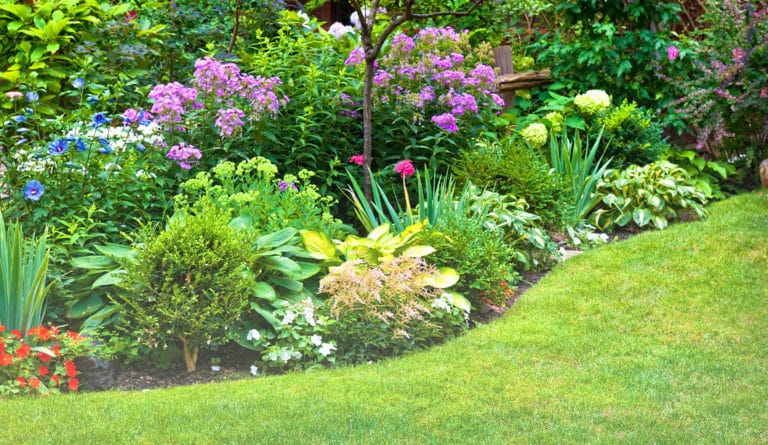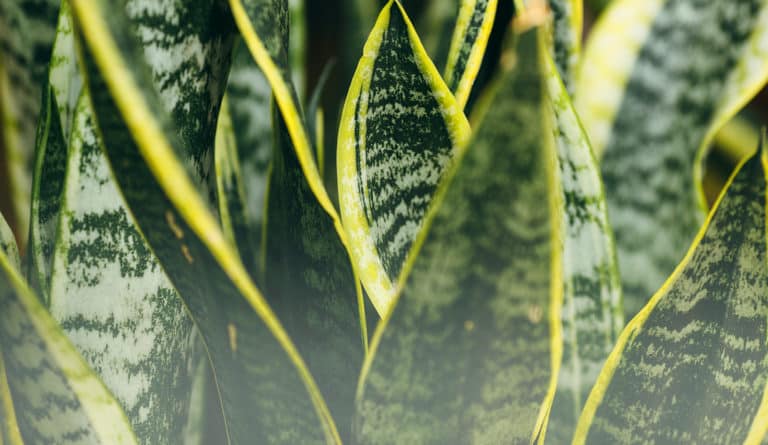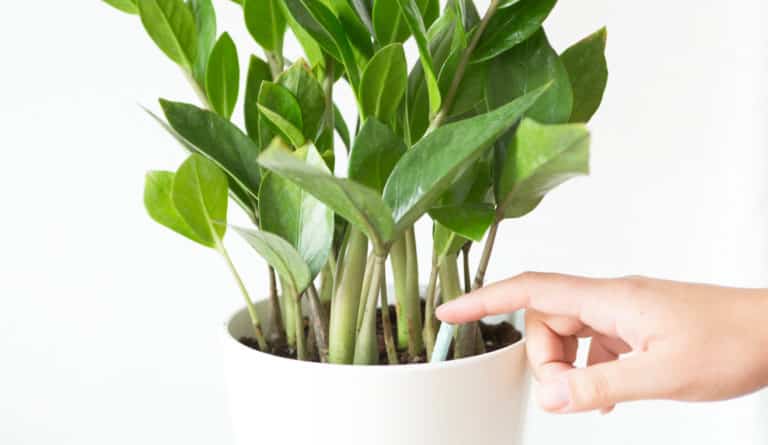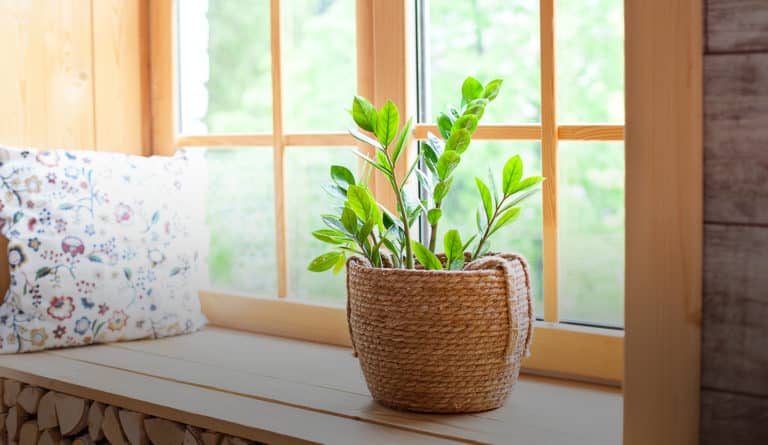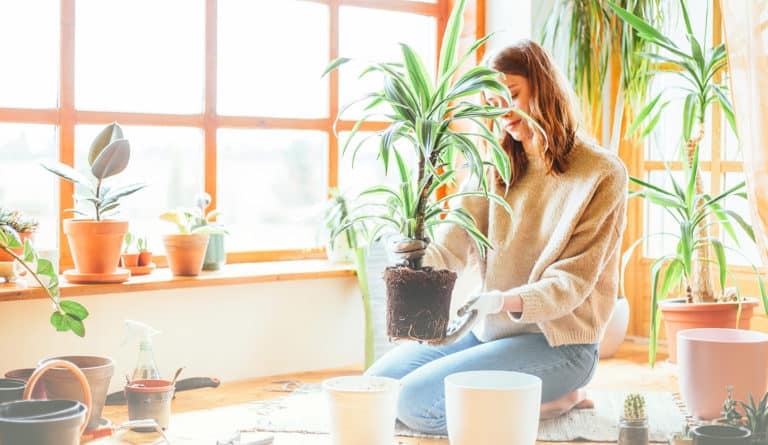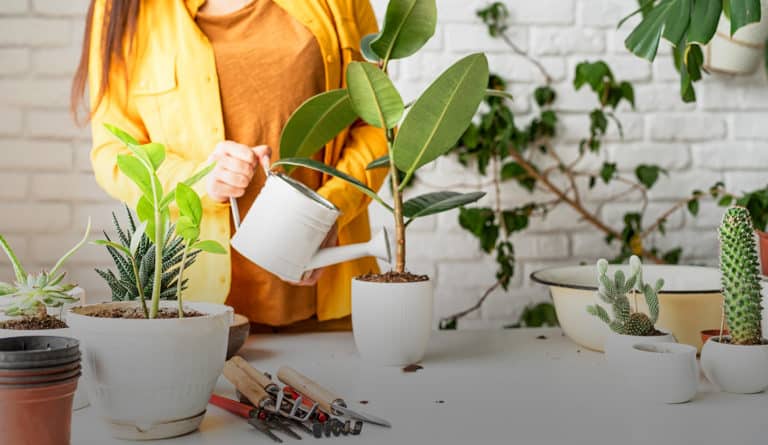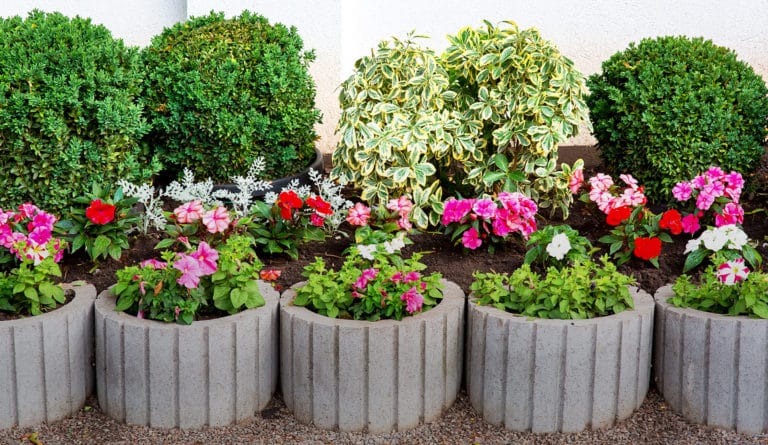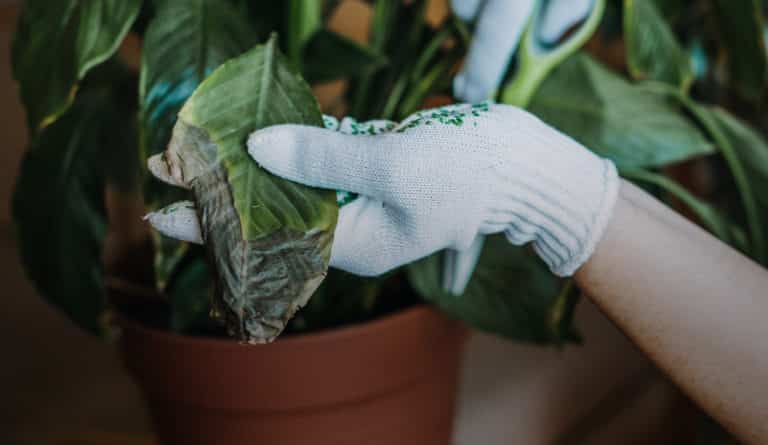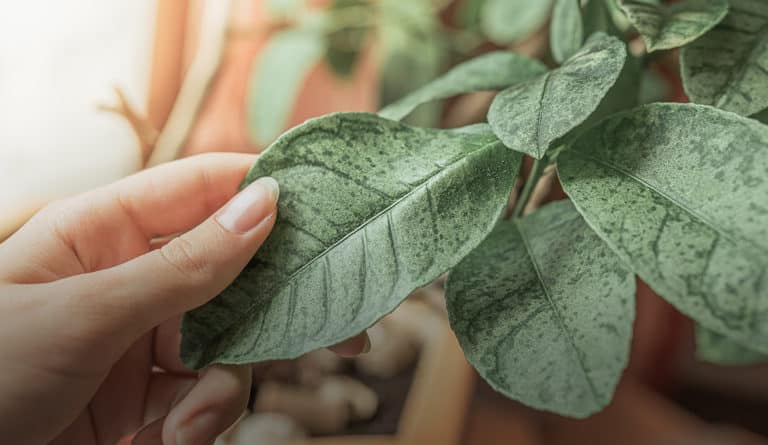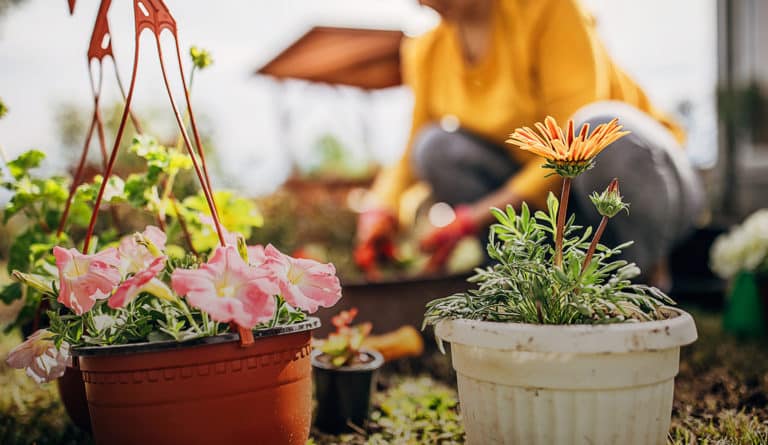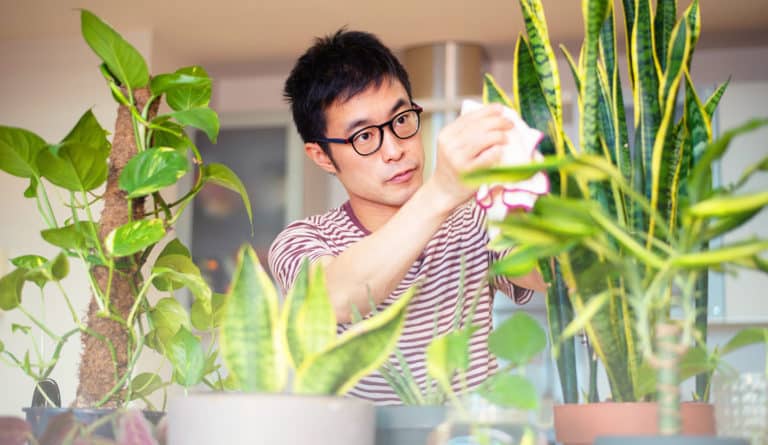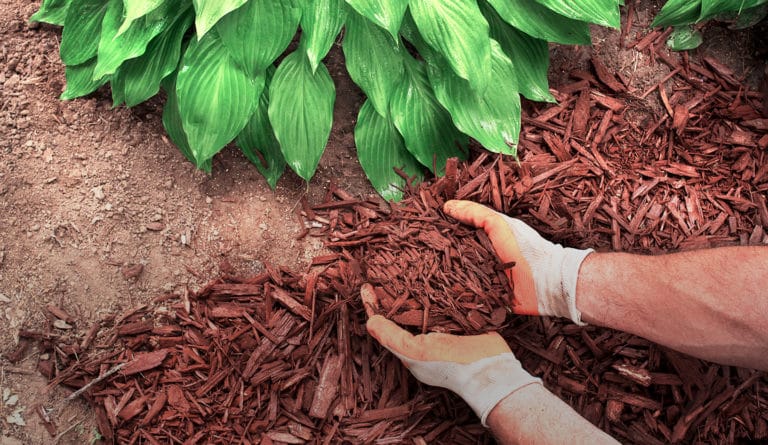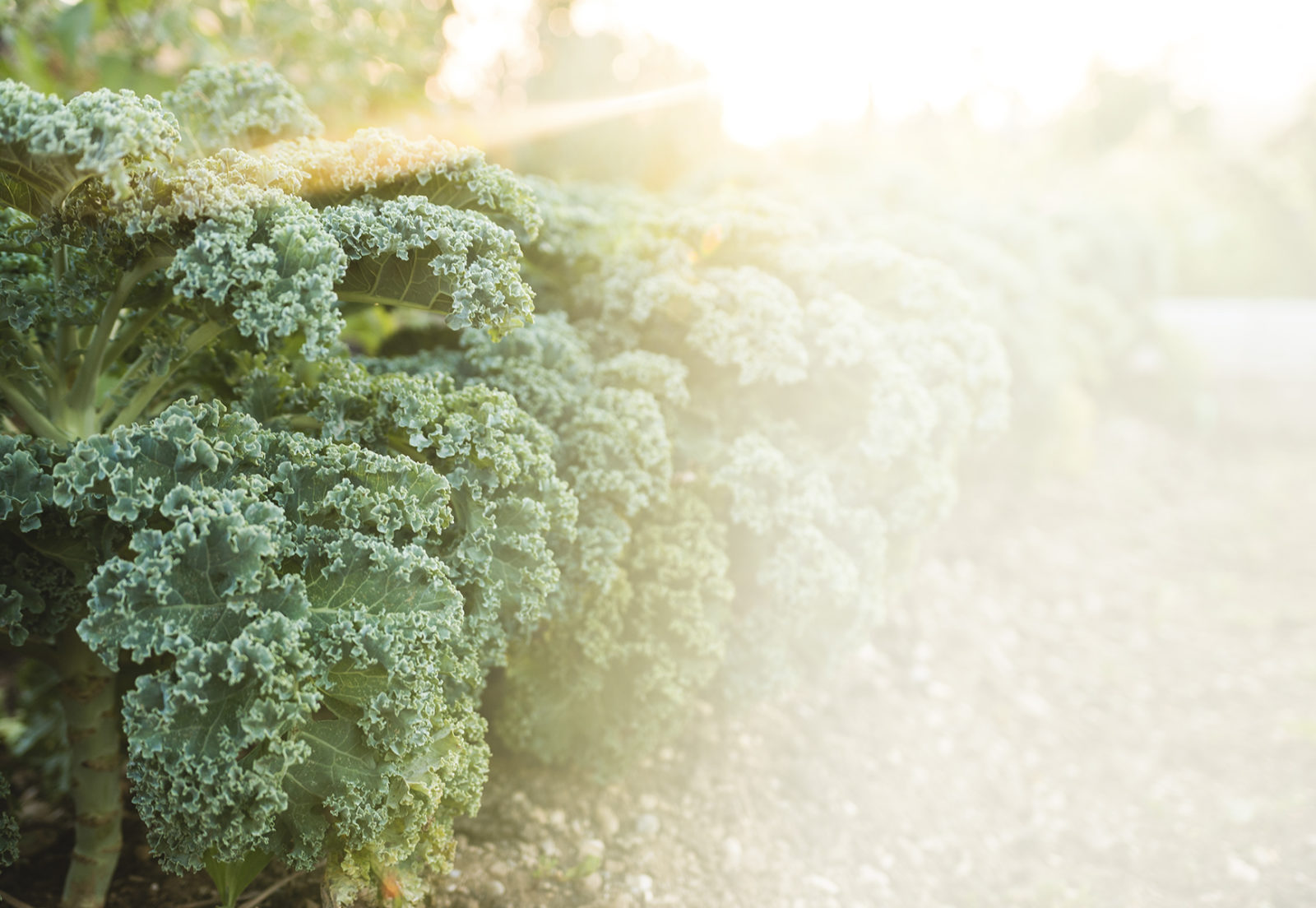
kale
aka brassica oleracea var. sabellica
Kale is a cold-hardy and resilient green veggie.
variations
Red Russian, Lacinato, True Siberian, Vates Blue Curled, Winterbor
light
just a little
Kale only needs about 3 hours of sunlight to grow
water + feeding
keep it watered.
Kale needs consistent watering. Your kale needs about 2 inches of water a week.
toxic
okay for humans
But could cause kidney and bladder stones for dogs.
size
small-ish
Can grow between 1 – 2 ft
pro tip
sweetened by frost.
Kale can be harvested until it’s 20°F/-7°C outside. In fact, the first nips of frost can make your kale taste better.
fun fact
technically a biennia
It’s a 2-year plant that produces leaves in the first year and a flower stalk in its second year.
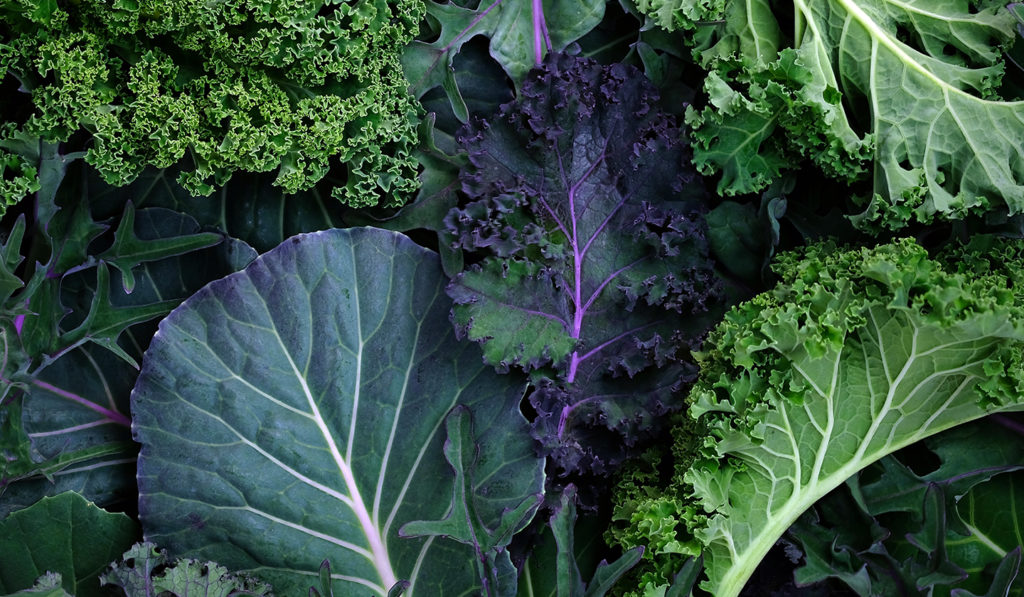
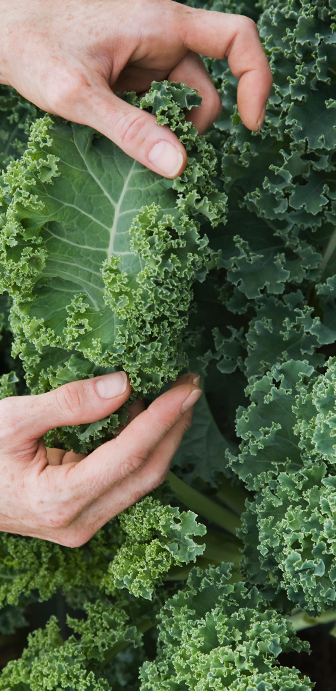
beyond the basics
-
companion planting
Kale works well when planted by artichokes, beets, celery, cucumber, lettuce, onion, peas, potatoes. Avoid other brassicas being planted alongside kale. These include broccoli, kohlrabi, cauliflower, brussels sprouts, and Swiss chard.
-
Harvesting
When your kale’s leaves are about the size of your hand, it’s ready to harvest. Be sure not to pick more than a third of your plant’s leaves at a time.
-
pest control
What are these little white flies? They are literally Whiteflies. They drink sap and excrete a sticky ‘honeydew’ which also encourages mould. Use sticky traps or Ortho® Bug B Gon® ECO Insecticidal Soap to keep your plants healthy.
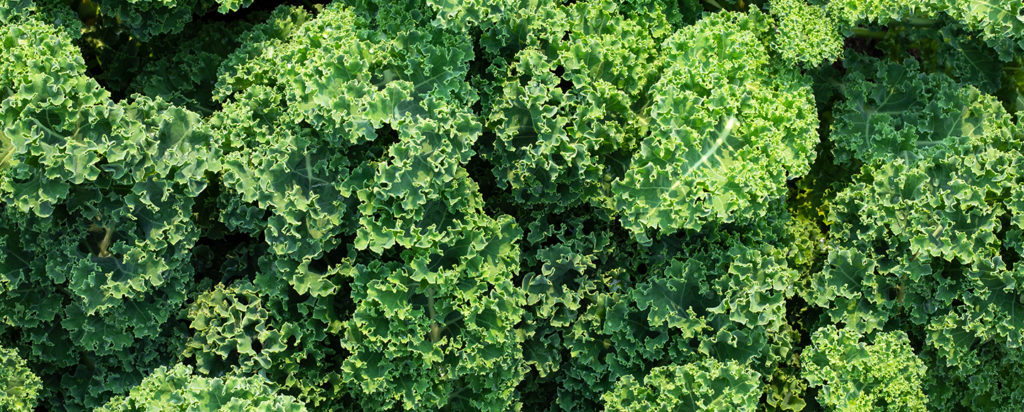
troubleshooting
-
why are my leaves full of holes?
Cabbageworms. You can use companion plants to help naturally combat these pests. Quickly hand pick your kale, and don’t forget to use row covers to help keep your kale safe.
-
what are these weird yellow V-shape on leaves and rotting stems on my kale?
Probably black rot. This is a fungus that leave yellow v-shapes on your kale’s leaf edges. To prevent this, make sure to rotate your crops and remove debris from your garden. Don’t forget to make sure your garden has good drainage.
-
why are my kale’s leaves misshapen?
Could be aphids. To prevent aphids from infesting your kale plants be sure not to water the foliage. If aphids persist, you can use an insecticide like Ortho® Bug B Gon® ECO Insecticide Ready-to-Use.
.
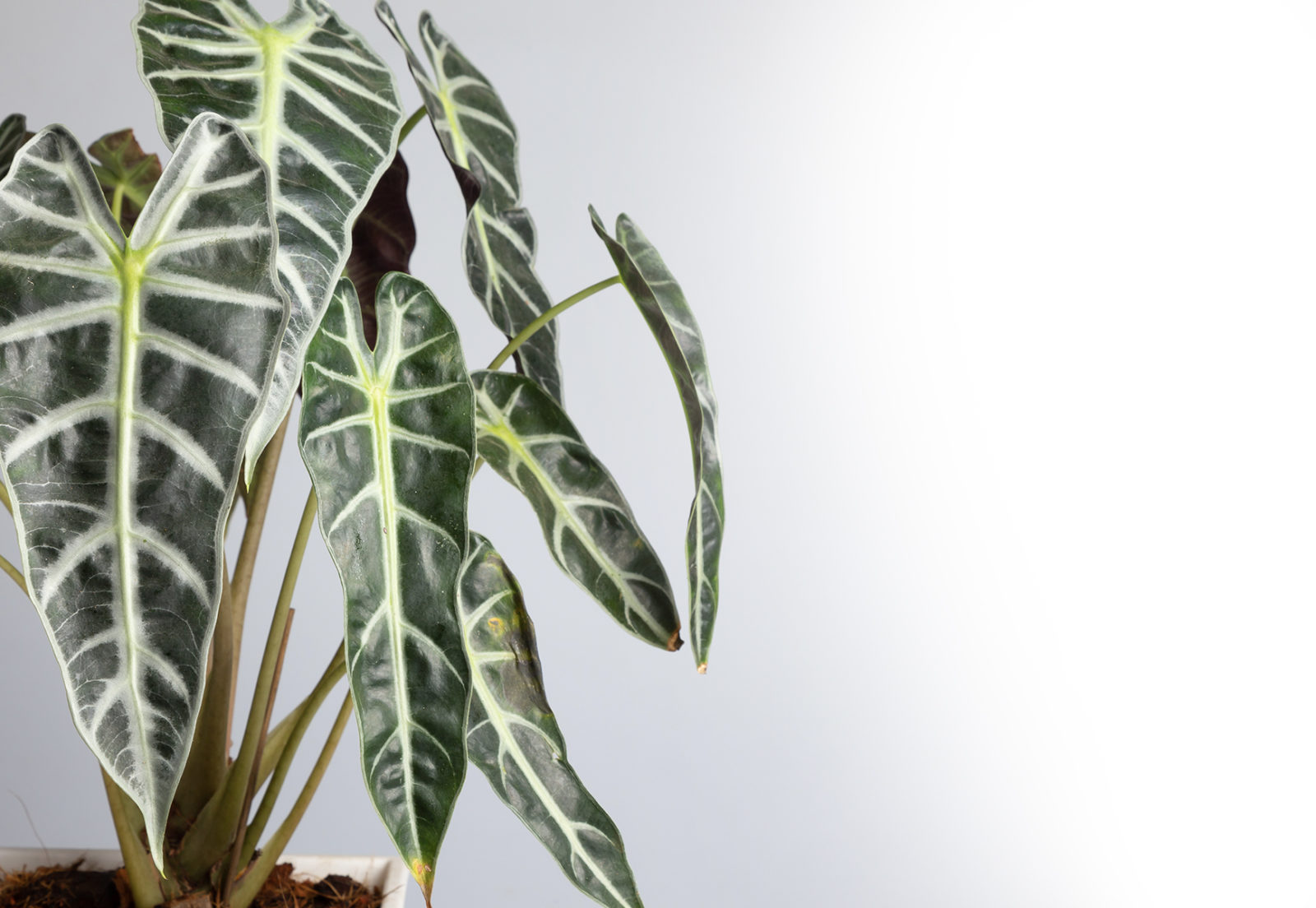
elephant ear
aka colocasia esculenta
Always the centre of attention, these big beauties make a statement indoors and out. They can grow to an impressive height with leaves that mimic hearts, or the shape of elephant ears.
variations
alocasias and colocasias
light
full sun
Even dappled shade will work
water + feeding
thirsty
Keep the soil moist. In summer months you may have to water your potted plant almost every day.
toxic
toxic to people and animals
Ingesting stems or leaves can cause a burning sensation or cause swelling. In some cases touching the plant can cause a skin irritation.
location
flexible
Elephant ears do well on patios and indoors. Keep your plant in indirect light to avoid it getting sunburnt.
humidity
love it
Elephant ears are tropical plants that thrive in warm, humid environments.
size
large friend
Can grow to 3 – 5 ft
pro tip
Leave lots of room
Elephant ears need a big pot to grow to their fullest potential.
fun fact
A tropical bulb
Elephant ears have tuberous roots that are often referred to as bulbs. Unlike common garden bulbs, these ones are not cold hardy so you’ll need over-winter the bulbs inside.
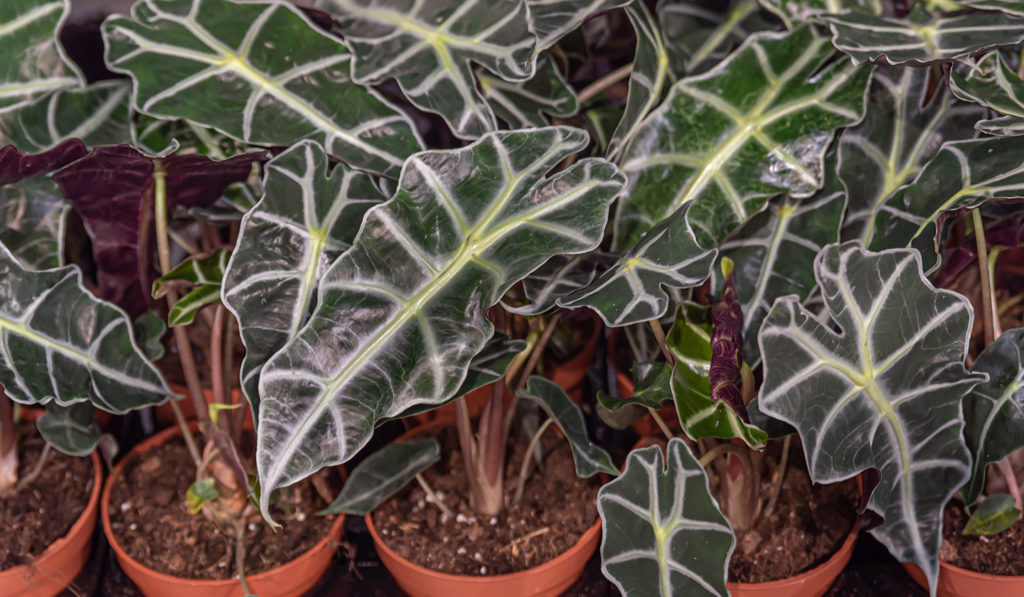
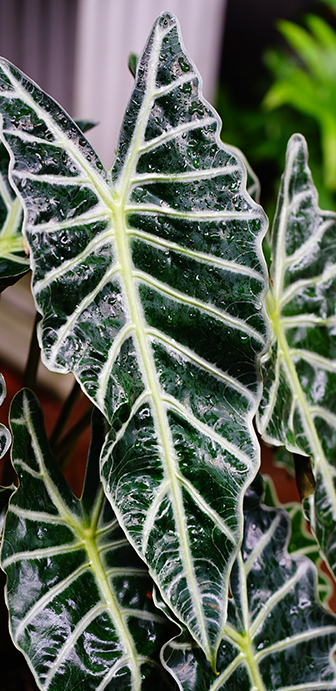
beyond the basics
-
soil + potting
Consider elevating your elephant ear slightly by adding a layer of rocks and pebbles between the planter and its saucer. This helps increase the humidity and prevents root rot. Use a well-draining soil for your elephant ear. Consider using Miracle-Gro Cactus, Palm & Succulent Potting Mix or Miracle-Gro Moisture Control Potting Mix for a happy plant.
-
when to repot
The best time to repot your elephant ear is during the spring months. When repotting your elephant ear, make sure to use a well-draining soil. Consider using a soil like Miracle-Gro Cactus, Palm & Succulent Potting Mix or Miracle-Gro Moisture Control Potting Mix to help refresh the soil.
-
propagation
While you can’t propagate an elephant ear with a cutting, you can divide tubers of a healthy adult plant. The tubers have a texture similar to that of a potato. You can easily cut through it with a sharp knife. Plant the divided tuber immediately into your potting soil and keep it moderately wet.
-
pest control
Common pests for elephant ears are aphids, spidermites and mealybugs. Use a gentle insecticide like Ortho® Bug B Gon® ECO Insecticide Ready-to-Use and make sure the leaves of your plant are treated as well.
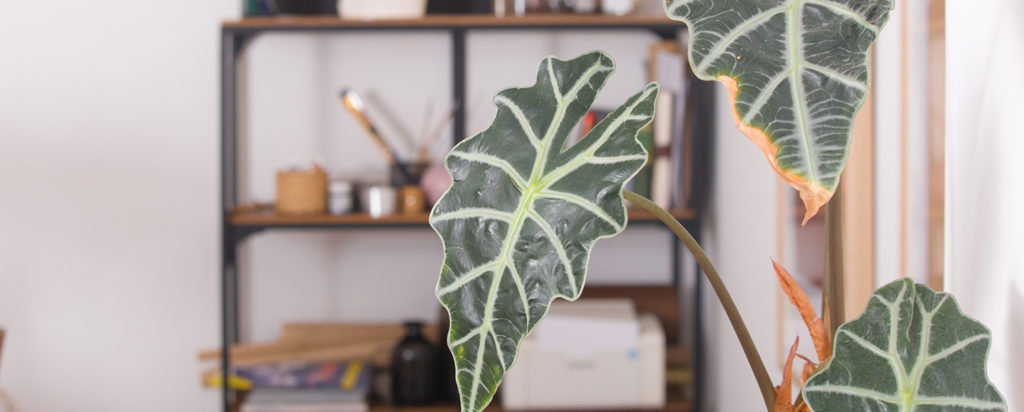
troubleshooting
-
why is my elephant ear turning yellow?
Too much sunlight or overwatering. You can cut the dying leaves close to the base of the stem. This should prevent more leaves from yellowing. Then adjust your watering schedule or move it away from direct sunlight.
-
why are my leaves crying?
Usually due to overwatering. The leaves of an elephant ear are long and heart-shaped, which naturally draws water to the tip of the leaf. If there aren’t other signs of overwatering, like soft stems or yellow leaves, you can likely hold off on watering for a few days.
-
why are my plant’s leaves turning brown?
It’s a sunburn. Your plant is too close to bright, direct light. Elephant ears tend to thrive in bright, indirect light. Scorched leaves won’t kill your plant, it just doesn’t look pretty.
-
Why does my plant’s leaves have spots?
Fungal leaf blight. If this fungus isn’t caught early, it will cause the whole leaf to collapse and travel to the rest of the plant. To prevent this, make sure you’re using high-quality, well-draining soil.
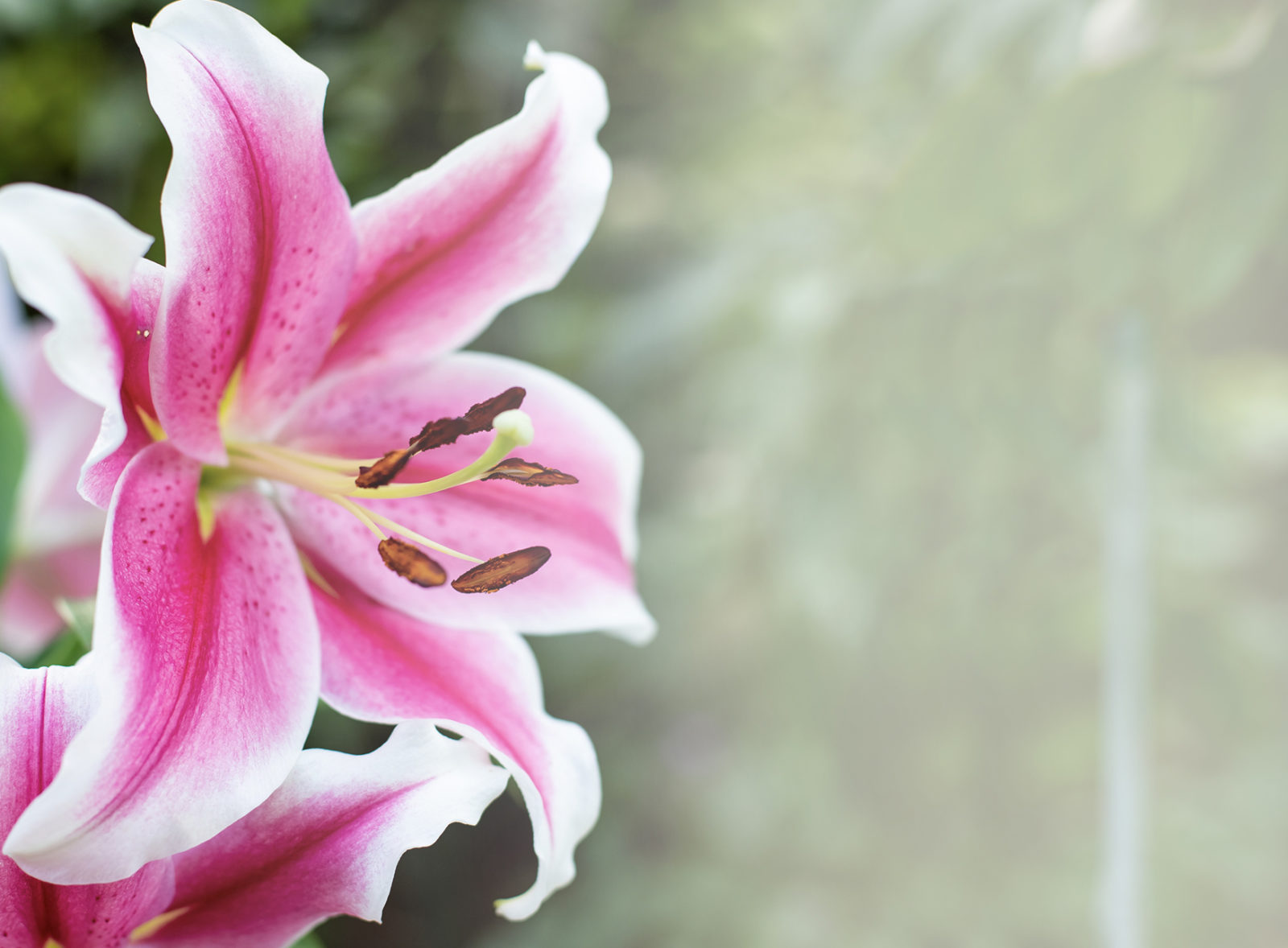
Lily
aka Lilium
lilies are an exotic and elegant perennial flower that are quite easy to grow. Lilies start as onion-like bulbs and require good soil and lots of sun to flourish.
variations
trumpet lilies, Asiatic lilies, Easter lilies, Oriental lilies
light
full sun
Your lilies will enjoy about 6 – 8 hours of sunlight but be sure to keep their roots cool.
water + feeding
thirsty
Water your lilies freely, especially if you’re not in a climate that gets much rainfall in the summer months.
toxic
yes, the whole plant
The entire plant is toxic to humans and pets. Even the water that fresh cut lilies sit in can make you and your fuzzy friends sick.
location
in the sun
A good rule of thumb is that lilies like their head in the sun and their feet in the shade. To help keep your lily’s roots cool, consider planting with low profile annuals or perennials, or ornamental grasses.
size
medium to large
Lilies can grow between 2 – 8 ft tall!
pro tip
lots at stake
Lilies can grow quite tall. Consider staking your lilies to keep them tall and upright.
fun fact
powerful native plants
Lilies are attractive to many insects because of their bright colours and sweet nectar. They can be pollinated by either the wind or bees!
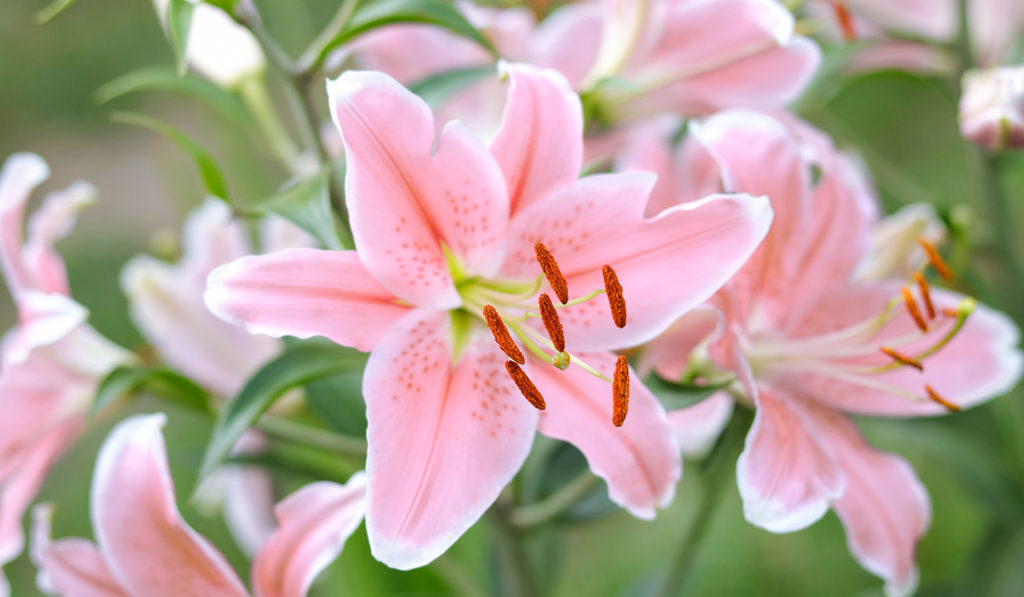
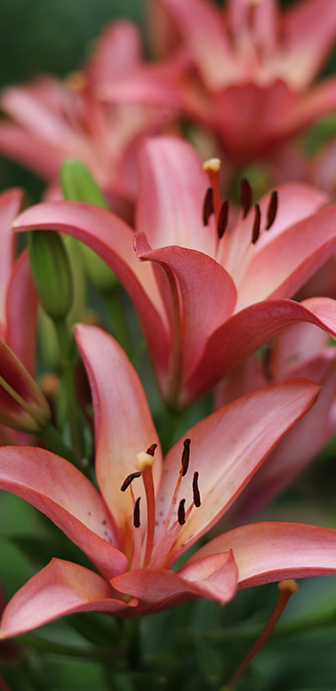
beyond the basics
-
soil + potting
Lilies love to have their roots in cool soil, and their heads in the sun. The best soil option to keep your lilies happy is a rich, moist soil. that is also well-draining. Consider adding in just a little bit of organic compost.
-
companion planting
You can find a wide variety of companion plants from annuals, bulbs to
other perennials. Consider using annuals such as dill, geraniums, pansies, or new guinea impatiens. Dahlias, daffodils, or irises make great companions when planting other bulbs. Perennials such as peonies, daisies and lavender are excellent companions for lilies. -
Blooms
Lilies only bloom once per season. You can remove, or deadhead, faded flowers to keep your plant from wasting energy making new seeds.
-
pest control
The most common pest issues for lilies are infestations of scarlet lily beetles. These little guys like to hang out on the underside of leaves. The easiest way to get rid of these little pests is to catch them manually by holding a bottle of warm water under the leaves you’re inspecting. The bugs will be startled and drop off into the water waiting below.
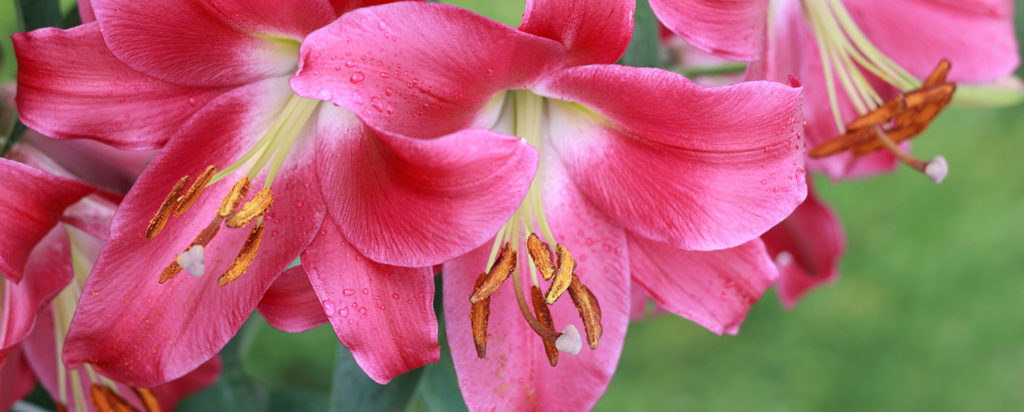
troubleshooting
-
what are those oval-shaped spots on my leaves?
Lily disease. This is a fungal infection that creates oval-shaped dark spots on your lily’s leaves. Make sure you use clean tools before you get started. Then clear out the infected soil and debris and get rid of the infected plant. Be sure to not plant lilies in an infected spot again.
-
why are the tips of my leaves turning brown?
Could be overwatering, sunburn, or underwatering. If the tip of the leaf is brown and crunchy, this means the soil is likely too dry.
-
why are my buds rotting?
Likely a fungus. Many fungi (Rhizoctonia, Phytophthora, Pythium, Fusarium, and Cylindrocarpon) attack the bulb and cause the roots to rot. This will also cause the plant to wilt, and eventually die. Be sure to remove the infected plants and check all bulbs carefully before planting.
-
why aren’t my lilies blooming?
Could be the result of small bulbs or over-crowding in the soil. Planting your lily bulbs too shallow could also lead to your lily not producing big blooms. If you cut away the leaves after a lily has flowered, it may also decrease the likelihood of flowering the following year. Keep in mind, some lilies won’t flower in their first year of planting due to transplant shock.
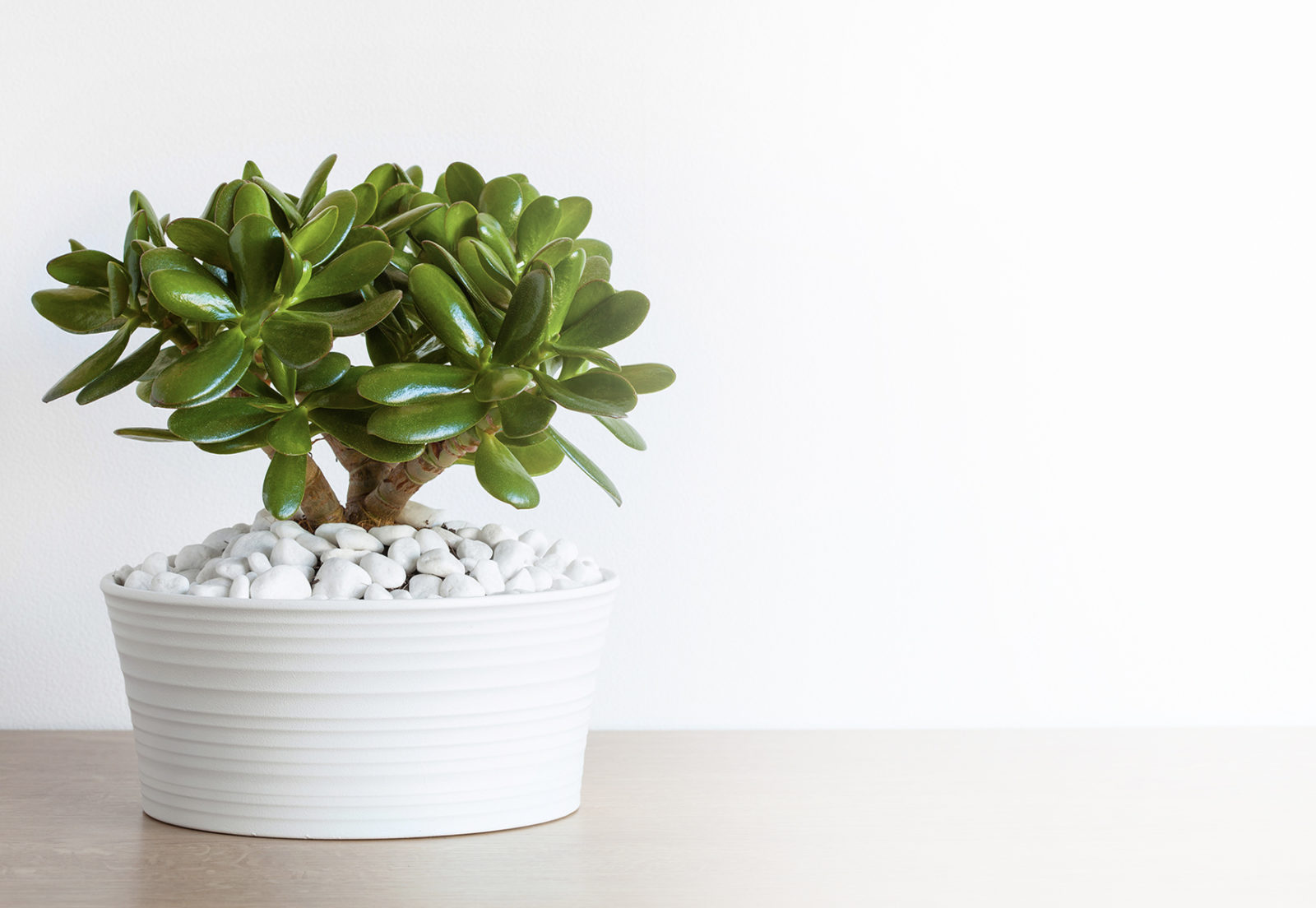
jade
aka crassula ovata
Jade plants are native to South Africa and are classified as a succulent. Jade plants have oval shaped, fleshy leaves and stems that look like tiny tree trunks.
variations
there are a variation of jade plants available that range from the common green-leaf to more rare variegated varieties. Variegated jade plants can include the tricolour, ET’s Finger or the Hummel’s Sunset variety.
light
bright, indirect.
Jade plants, especially young plants, should get about 6 – 8 hours of light a day.
water + feeding
somewhat thirsty
In spring and summer your jade plant should be watered consistently so that its soil is moist, but not super wet.
toxic
Yes
Jade is toxic to pets.
location
Adaptable
These beautiful plants do well in most indoor settings, but prefer to be close to bright, indirect light. Jade does their best growing in room temperature 18° to 24°C (65° to 75°F).
humidity
a little finnicky
Overwatering and standing water are the most common mistakes made with jade plants. Be sure to monitor your jade for signs of too much moisture.
size
it depends
Jade plants can grow up to 5 ft tall but can stay small if they are rootbound in a small pot.
pro tip
rare flowers
Jade plants don’t regularly flower when grown indoors. To get your jade plant to flower keep it rootbound and in a small pot. Cut back slightly on watering, and you may see a bloom come through.
fun fact
bringers of good luck
Jade is often given as a housewarming gift because it’s thought to bring good luck.
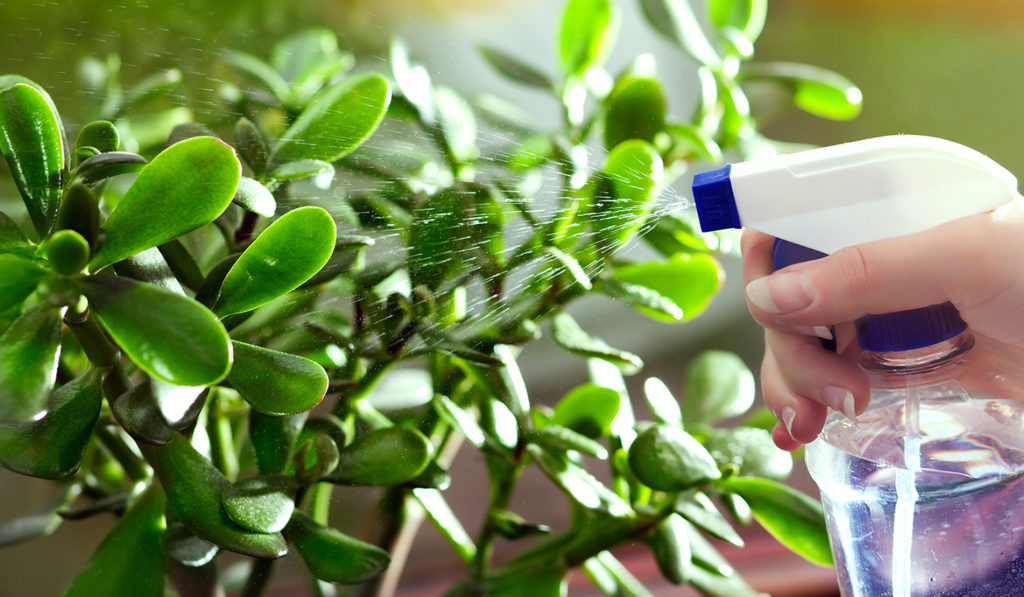
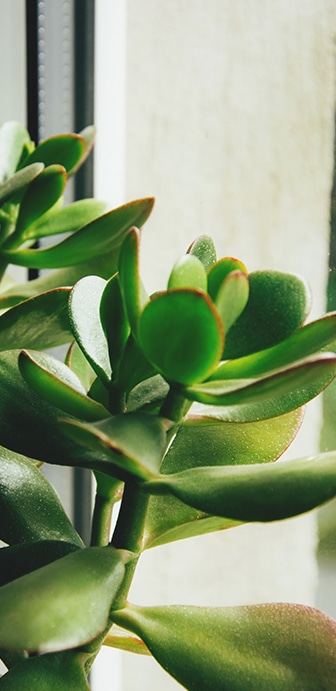
beyond the basics
-
soil + potting
Succulents thrive in porous, well draining potting mix. These usually have less organic matter than regular indoor potting mix. A mix like Miracle-Gro® Cactus, Palm & Succulent Potting Mix is well-draining and won’t compact. Don’t forget to feed your plants consistently during the feeding season.
-
when to repot
Repotting a young jade plant every 2 – 3 years will encourage growth. If you want to keep your jade plant small, they enjoy being slightly rootbound and can stay in a small pot to maintain a manageable size. Always repot in the spring.
-
propagation
Propagating a jade plant is super easy! You can start a whole new jade from just a single leaf or cutting. Remove a leaf or stem cutting from a healthy, mature plant, making sure it’s about 2-3 inches long and has at least 2 leaf pairs. Let the cutting sit in a warm, bright place for several days to develop a little callous. Place the cutting in moist, well-draining soil, keeping it propped upright with rocks. Be sure not to water your jade cutting at this point. After a week or two roots should start to form. Gently water the soil once roots have formed, and allow soil to dry between watering.
-
pest control
Jade is prone to mealybugs and scale. Mealybugs may hide under the leaves of your plant. During your routine leaf cleaning, inspect the underside. Most pests can be managed by using an insecticidal soap such as Ortho® Bug B Gon® ECO Insecticidal Soap. For more tips, check out our Pest control section in Plant 101 for how to identify and deal with pests on your plant!
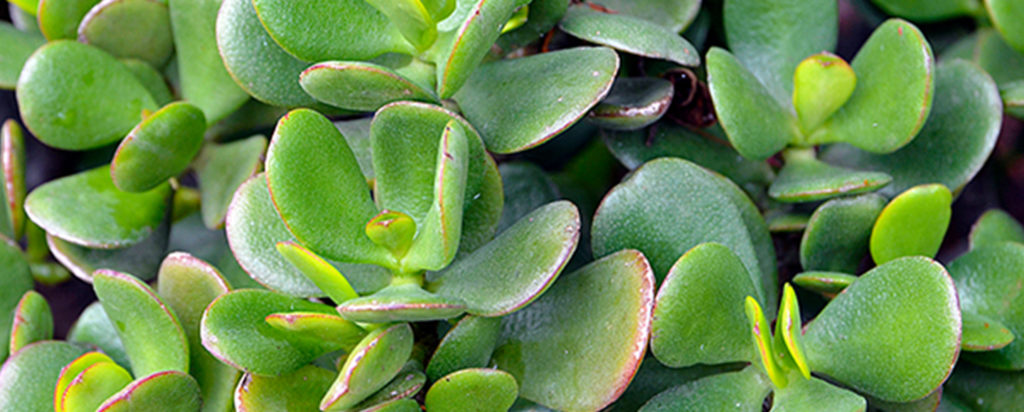
troubleshooting
-
why are my leaves dropping?
Overwatering. While young jade plants need thorough watering, if your jade’s leaves are squishy and dropping it’s definitely getting overwatered.
-
why are my leaves shrivelling?
Underwatering. These are clear signs that your jade is asking for more frequent or deeper watering.
-
why are the stems getting squishy?
Root rot. Do a quick inspection of your plant’s root ball. A healthy root will be firm a white. If your plant’s roots are looking brown or slimy, it’s definitely root rot. To avoid this, be sure the soil is drying out completely between watering.
-
why are my leaves spotty?
You’ve got scale. These insects feed on the sap in your jade’s leaves. You can quickly remedy this problem by applying Ortho® Bug B Gon® ECO Insecticidal Soap.
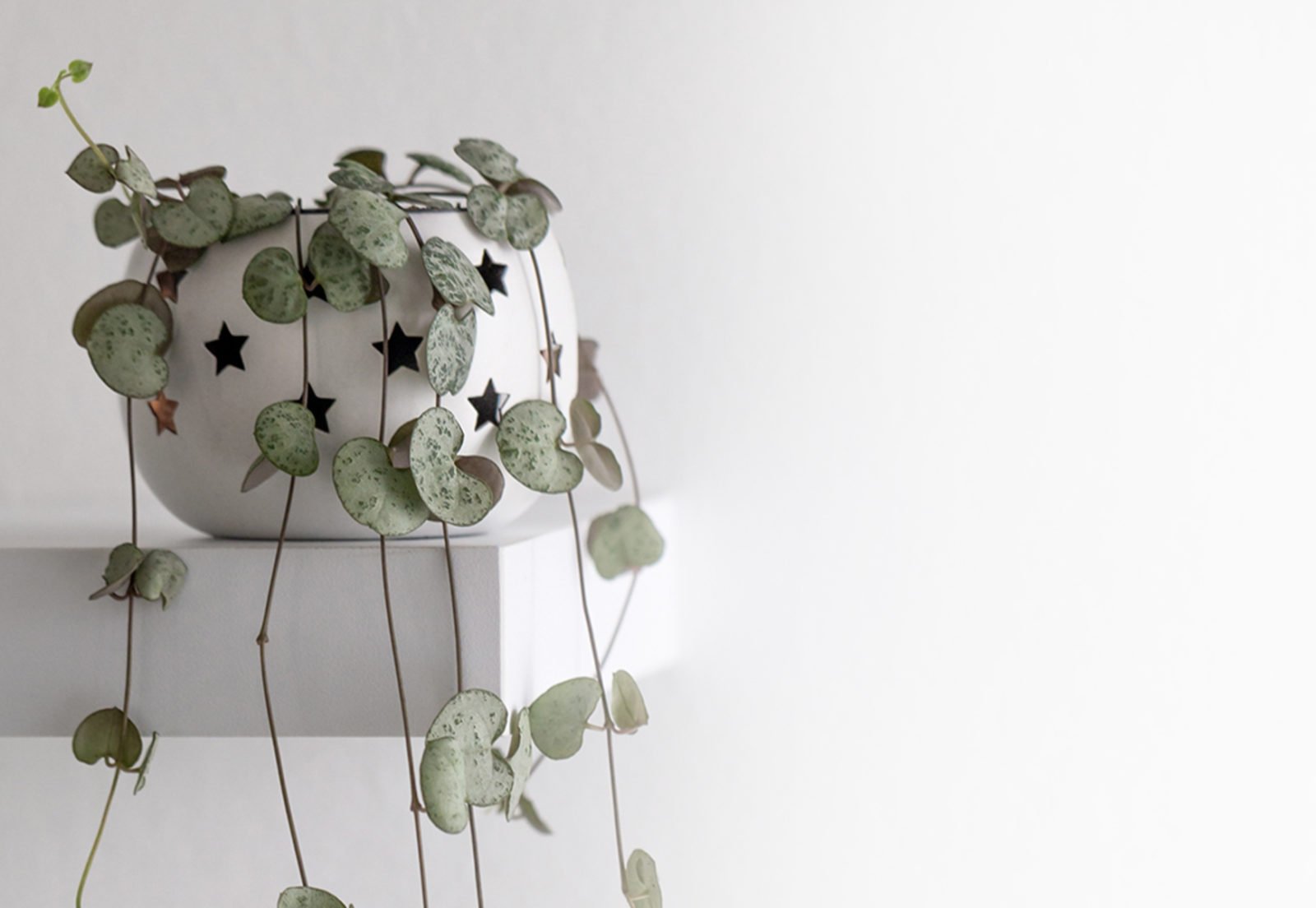
string of hearts
aka ceropegia woodii
this beautiful trailing succulent is native to South Africa, Swaziland and Zimbabwe. This plant is named for the sweet, heart-shaped leaves.
variations
the more sun it gets, the more variegated the leaves will get. Leaves can get silver, cream or even pink markings.
light
bright, indirect.
Ample bright, indirect light will lead to greater variegation in the leaves.
water + feeding
somewhat thirsty
Can be watered 1-2 times a week in the spring and summer, once every week or two during the fall and winter.
toxic
no
This plant is safe for pets.
location
somewhere bright
Place near your brightest window. South or West facing windows is recommended
humidity
not too fussy
Can tolerate drier climate but thrive in about 40-50% humidity.
size
small-ish
Can grow up to 3 inches tall and have trailing stems that can grow to 3 – 9 ft long.
pro tip
sun baths
Colour can be revived by placing your plant by a bright window. Leaves can return to their vibrant colours and even turn pink.
fun fact
fast Growers
They’re fast growers and very easy to care for, making them popular houseplants for beginners.
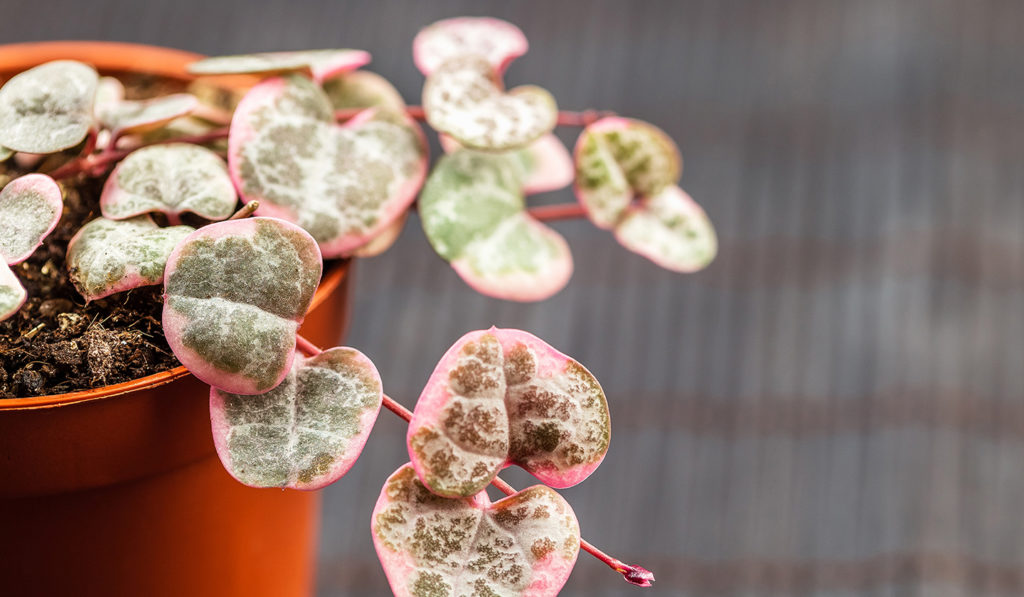
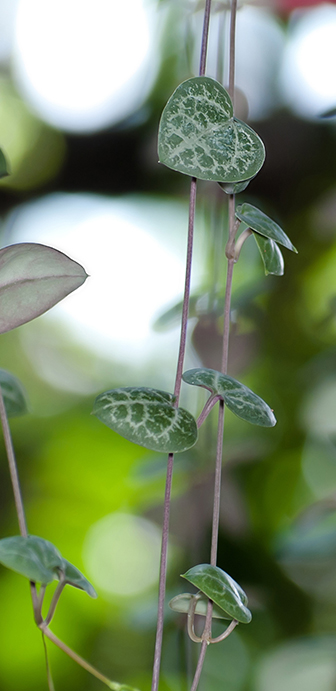
beyond the basics
-
soil + potting
String of heart plants are a member of the succulent family, so they need a porous, well-draining potting mix that doesn’t retain a lot of moisture because these beauties are prone to root rot. It’s recommended to use a succulent specific potting mix, like Miracle-Gro® Cactus, Palm & Succulent Potting Mix.
-
when to repot
String of hearts tend to be okay with staying slightly rootbound, so you don’t need to keep a strict schedule when repotting. A good rule of thumb is to repot about every 1 – 2 years. Use a pot that is a few inches bigger than its current pot and has a drainage hole.
-
propagation
Start by trimming your string of hearts just under a nodule. Place your cutting in moist soil and watch your new plant take root. This process will likely take about a month. Make sure the soil is kept moist during this growing period.
-
pest control
String of hearts are prone to root rot, so make sure your plant’s soil is drying out between watering. Other pests like aphids or mealybugs can be managed by using an insecticidal soap such as Ortho® Bug B Gon® ECO Insecticidal Soap.
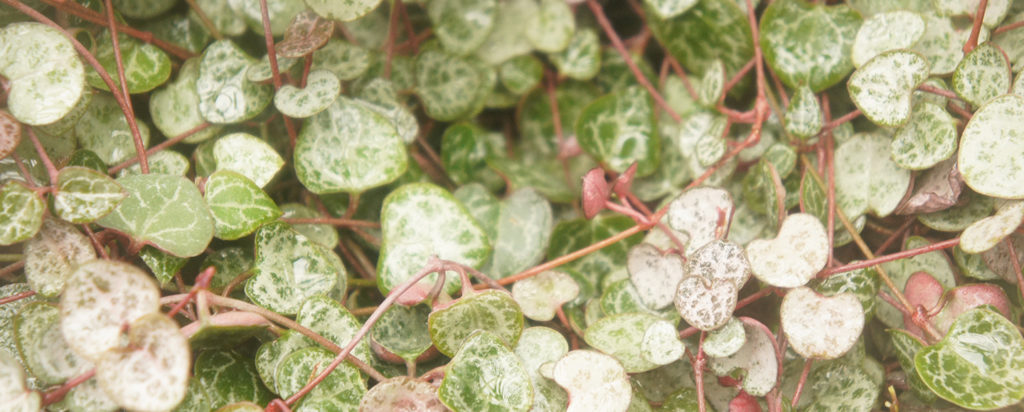
troubleshooting
-
why are there big gaps between my leaves?
Not enough light. Move your string of hearts to a place where it can sit in ample indirect, bright light.
-
why are my leaves turning mushy and droopy?
Overwatering or root rot. Root rot is caused by overwatering. The easiest way to tell if it’s root rot or just overwatering is to give it a sniff. If your plant smells bad, it’s root rot. If it smells okay, just hold off on watering it for a little the soil dries out a bit.
-
why are my leaves turning brown?
Sunburn. It looks like your string of hearts is getting too much sun. These plants enjoy bright, but indirect light. Move your plant away from direct sunlight, but keep in a nice, bright room.
-
why are my plant’s leaves curling?
Underwatering. Thinning or curling leaves is a clear indicator of underwatering. Give your string of hearts a good soak and your plant should be happily re-hydrated.
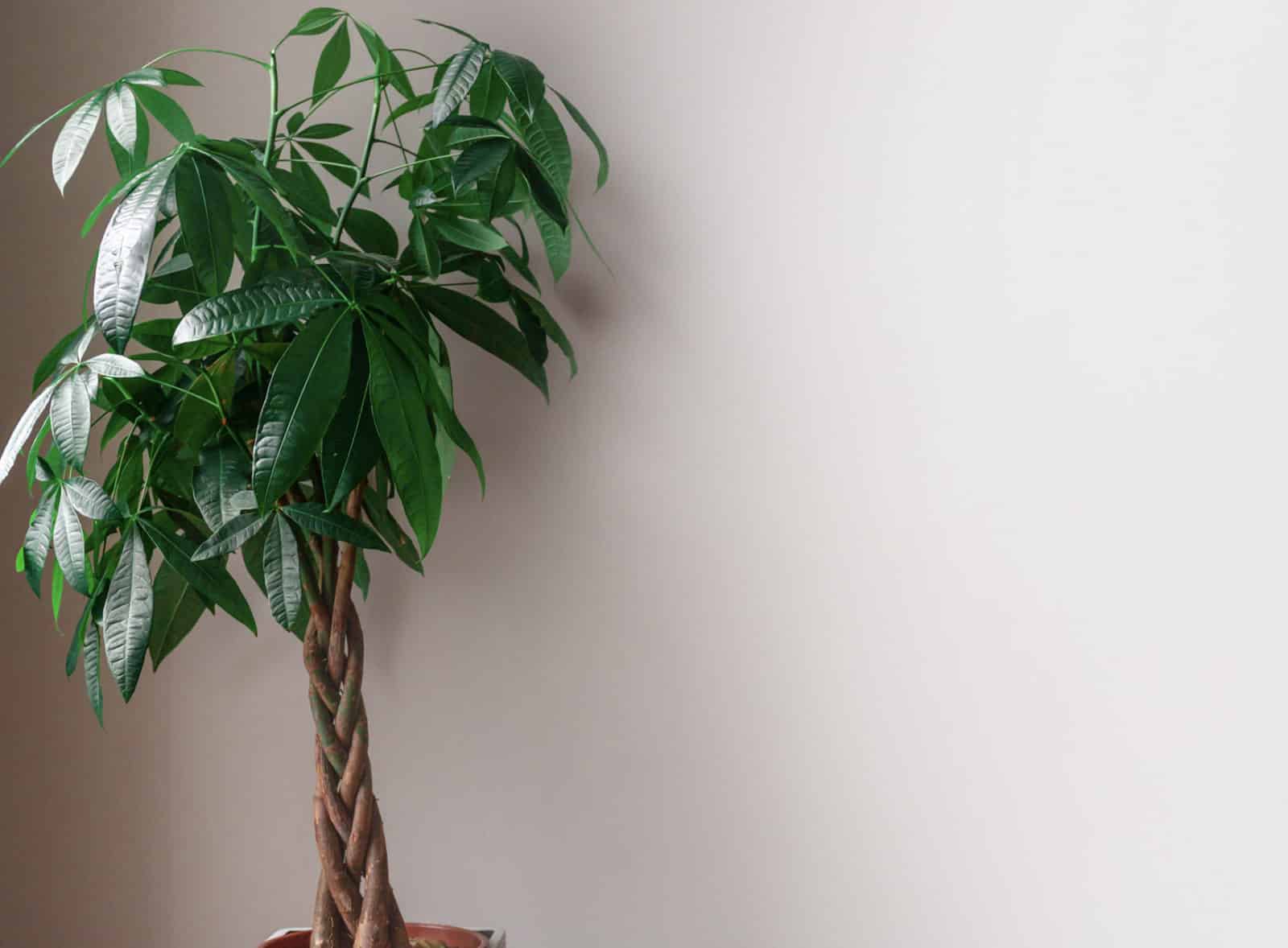
money tree
aka pachira aquatica
Money Trees originated from Central and South America. The braided trunk of the tree isn’t naturally occurring. This feature is created by cultivators braiding young trees manually.
variations
Variations include Malabar Chestnut, Provision Tree, Guiana Chestnut and French Peanut.
light
avoid direct sunlight
Too much direct sunlight will cause the leaves to curl, yellow or burn.
water + feeding
water when dry
However, these plants can still do well without watering too frequently.
toxic
safe for humans and pets
Money Trees are even recommended for people with allergies or asthma.
location
adaptable
Although it’s recommended not to keep this plant in your bathroom because it’s believed this will “flush” good vibes away.
humidity
love it!
Money Trees appreciate a humid climate, with about 50% humidity.
size
small to medium
At home, your money tree could grow between 3 to 5 feet. In the wild, these trees can grow up to 60 feet tall.
pro tip
get a humidifier
Prevent yellowing and dying leaves by increasing the humidity in the plant’s environment.
fun fact
popular in feng shui
This plant usually sprouts 5 leaves on a stem, and 5 is a very important number in Feng Shui.
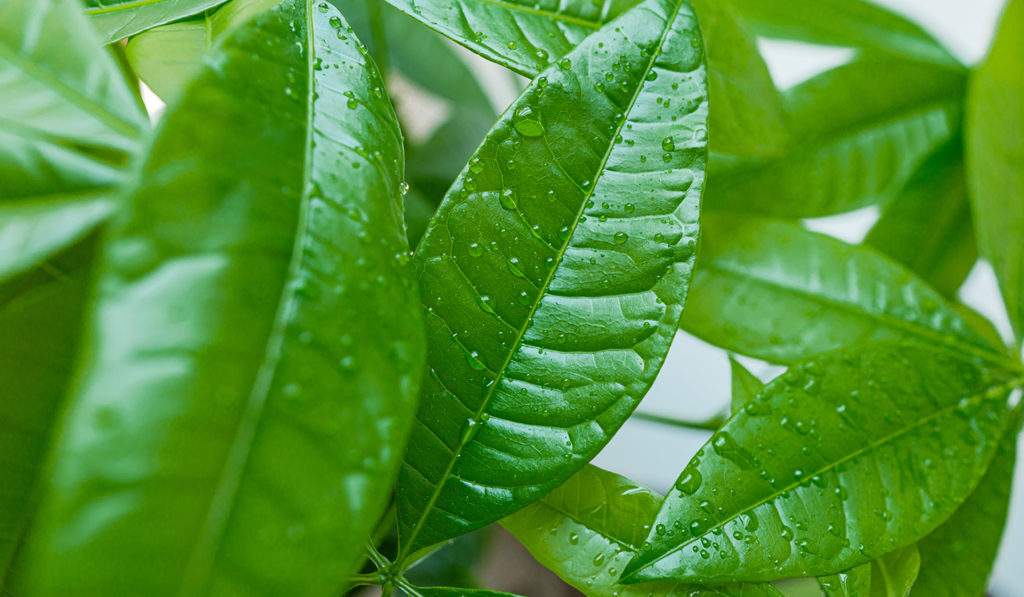
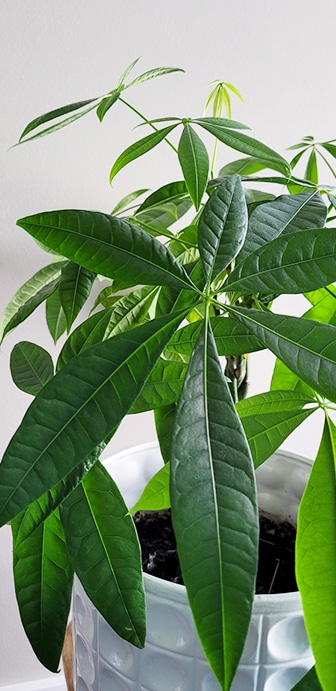
beyond the basics
-
soil + potting
Money Trees need a sandy, peat-moss based soil. Consider adding Miracle-Gro® Sphagnum Peat Moss to your plant’s soil. Don’t forget to use a pot with drainage!
-
when to repot
Money Trees usually need to be repotted every three years. The best time to repot is during the spring time, to promote growth. While you can cut back on some root growth, be sure not to take off more than 25% of the roots.
-
propagation
The best way to propagate your Money Tree is through a cutting. Take your 6 inch branch cutting, with several leaf nodes, and allow to root in water. Promptly transfer to a soil mixture with peat moss.
-
pest control
Money Trees are very attractive to aphids and mealybugs. You can use a gentle insecticide like Ortho® Bug B Gon® ECO Insecticide Ready-to-use to prevent these creepy crawlies from returning.
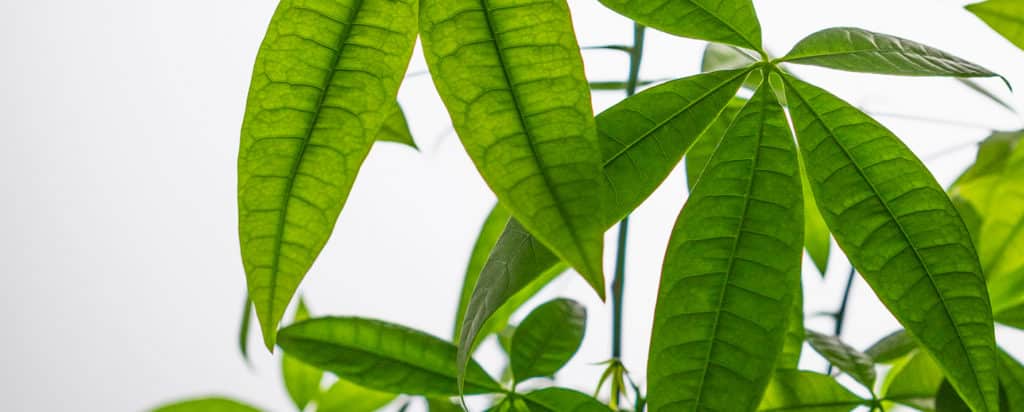
troubleshooting
-
why are my plant’s leaves drooping or turning yellow?
Watering issues. If your Money Tree’s leaves are drooping it could be as simple as inconsistent watering. Keep a schedule and check the soil’s moisture level to understand its needs. If the leaves are yellowing, it’s likely due to overwatering. It’s time to water when the top 2 to 4 inches of soil are dry.
-
why is my plant’s trunk spongey and soft?
Sounds like root rot. This happens when a fungus has attacked your plant’s roots and is a sign that you’ve been overwatering. Root rot can be fatal if it’s not caught early. The best chance you can give your Money Tree for survival is to repot immediately, removing as much old soil as possible.
-
what is this gross, sticky sap?
Guttation. This it totally normal! If the rest of your Money Tree looks healthy, there’s nothing to worry about. But… if you see little dark bumps on your plant, it could be a pest infestation.
-
why are my plant’s leaves curling?
Overwatering. Avoid excessive watering and finger test your plant’s soil when you’re about to water. Make sure you’re only watering when the first 2 to 4 inches of soil are dry.
-
why are my plant’s leaves falling?
Too much sunlight. Too much bright, direct sunlight can cause your Money Tree to drop leaves. Another common cause is if your Money Tree has recently moved to its new home. Dropping a few leaves as your plant adjusts to its new home is totally normal.
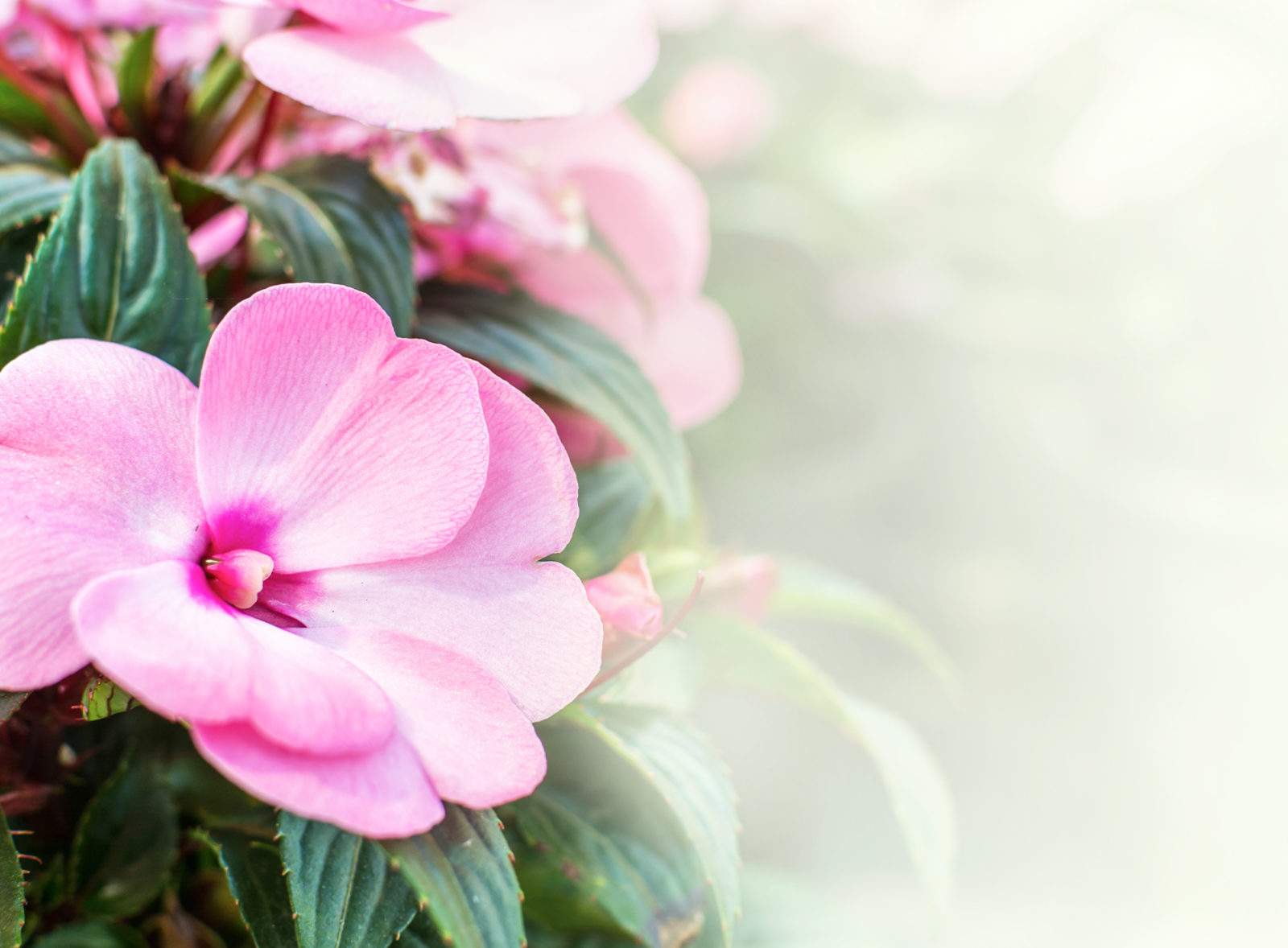
impatiens
aka impatiens walleriana
Bright, colourful and fast growing, in even the shade. Impatiens have the power to pretty things up nearly everywhere. Garden beds, planter boxes and even hanging baskets.
variations
Standard impatiens: Impatiens walleriana New Guinea impatiens: Impatiens hawkeri
light
shade or partial sun
Unlike most flowers, Impatiens grow well in shady conditions. The exception are the New Guinea varieties that prefer partial sun. If you can, pick a spot that’s protected from the wind.
water + feeding
thirsty
They like moist soil so keep the water coming. Two inches a week is a general rule. That’s an hour of sprinkler time if there’s no rain. Be careful not to overwater. Long periods of wet soil encourages mold and rot. A layer of mulch helps the soil retain moisture and protect impatiens from wilting in summer heat. Impatiens in containers need more regular watering than ones planted in your garden.
toxic
non-toxic
safe for people and pets.
size
really small to small-ish
Dwarf varieties only grow 6 inches. While bigger types can grow to 2 feet high with the proper care.
pro tip
dead heads
“Dead head” your Impatiens for continuous blooms. When you see a blossom start to brown and wither, pinch it off and toss it in your yard waste. This will encourage the plant to make more beautiful new flowers.
fun fact
so sweet!
In many cultures, Impatiens are symbolic of motherly love. But there are some cultures where the flower represents impatience, because the plant eagerly disperses seeds.
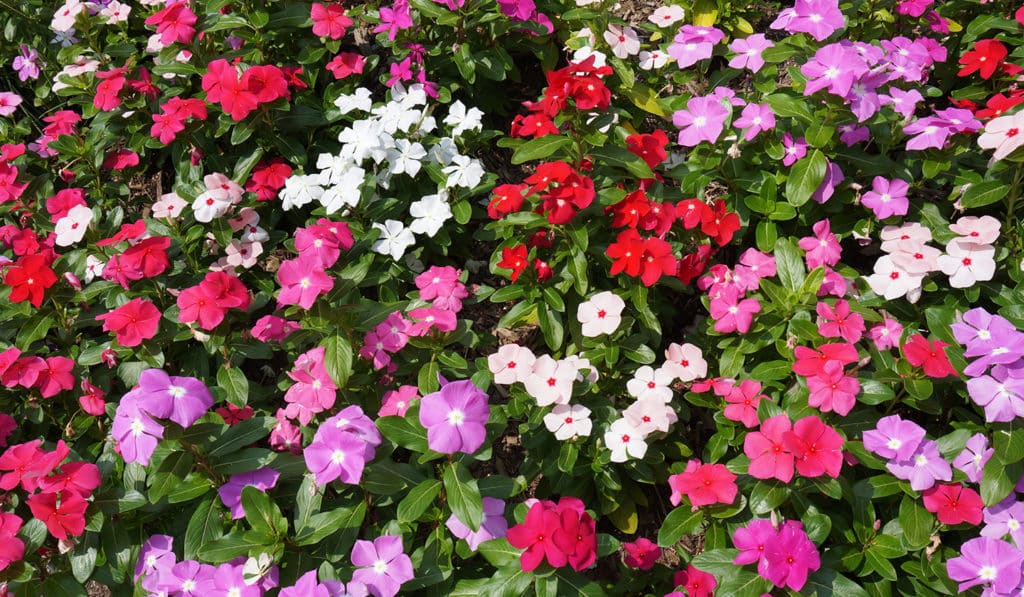
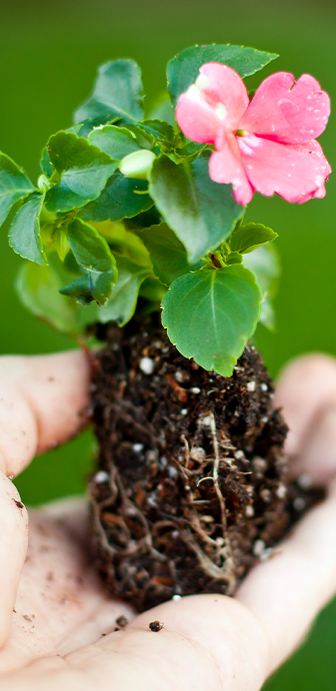
beyond the basics
-
soil & potting
Grow impatiens in nutrient-rich soil with good drainage. Adding peat moss to clay soil will help. If you’re planting in a container such as a window box or hanging basket, use a good-draining potting soil like Miracle-Gro® potting mix.
Enrich your soil with nutrients. Fertilize your soil with aged compost before planting. This organic matter will provide your impatiens the extra nutrients they need to thrive.
Plant food makes a big difference. Add a slow-release granular plant food at planting time, like Miracle-Gro® Shake ‘n Feed All Purpose Plant Food. Throughout the growing season, add a water-soluble plant food every two weeks such as Miracle-Gro® Water Soluble Bloom Booster. Use a water-soluble plant food every two weeks according to the instructions. You can also reapply the slow-release plant food midway through the season. Let’s boost those blooms!
Planting Impatiens close together encourages them to grow taller. Space them about six inches apart. Not any closer, because the crowding could encourage mold to grow. If you want your Impatiens to act like more of a sprawling ground cover, space them further apart, about a foot.
-
companion planting
Impatiens are good in a veggie garden because their cheery flowers attract pollinators. They also make excellent companions for other plants and flowers like Asparagus fern, Begonias, Bacopa, Coleus, Fuchsia, Sweet potato vine and White Baby’s Breath.
-
blooms
Impatiens provide a bounty of brightly colored blooms, even in shady areas. Colours include white, red, pink, violet, coral, purple, and yellow.
-
pest control
Impatiens are fairly pest resistant, but you may get Aphids (yellowish-green clusters of small insects) or Red Spider Mites (tiny red bugs and white dusty substance under leaves). Fight these pests with a gentle insecticide like Ortho® Bug B Gon ECO Insecticidial Soap. For prevention, try planting aromatic herbs nearby, like chamomile, garlic or rosemary.
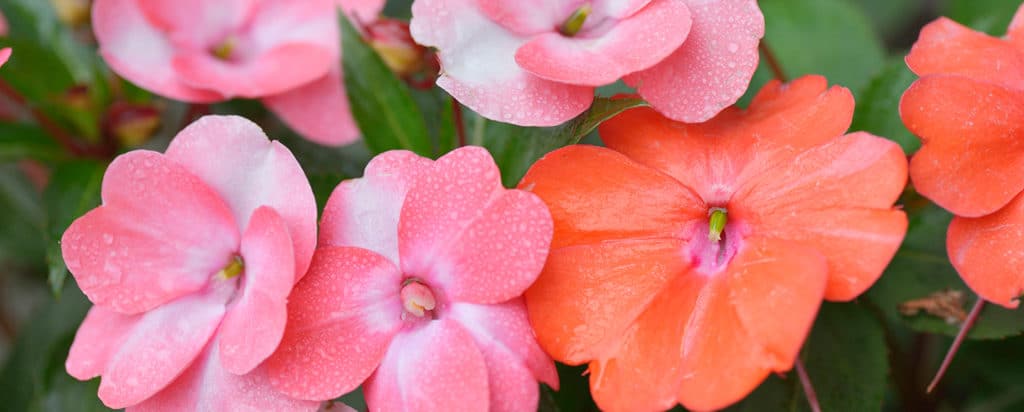
troubleshooting
-
what’s with the shrivelling blooms?
Impatiens blooms do have a life cycle and wilt naturally, but if all the blooms go suddenly at the same time, it’s probably a combination of too much heat and sun, and not enough water. Impatiens prefer shady, partial sun locations that shield them from peak daytime sun. Impatiens transplant well if you use lots of water, so move them to a shadier space.
-
why are my plants wilting?
Not enough water. Impatiens want consistently moist soil that doesn’t get soggy. Leaf drop and bud drop are other signs of drought stress.
-
what are these ringed spots?
Probably the Impatiens Necrotic Spot Virus. This incurable virus is spread by bugs known as Thrips. Unfortunately, there is no treatment. Stop the spread by uprooting and tossing the plant in a yard waste bag. Once it’s contained you can start over.
-
why is there powdery white stuff on the leaves?
It’s probably Downy Mildew, which can causes leaves to shrivel. It begins as a yellow or white stippling on the underside of the leaves. Prune infected leaves on generally healthy plants, and remove badly infected plants entirely. For maintenance, keep your beds clear of damp, rotting plant material.

impatiens
aka impatiens walleriana
Bright, colourful and fast growing, in even the shade. Impatiens have the power to pretty things up nearly everywhere. Garden beds, planter boxes and even hanging baskets.
variations
Standard impatiens: Impatiens walleriana New Guinea impatiens: Impatiens hawkeri
light
shade or partial sun
Unlike most flowers, Impatiens grow well in shady conditions. The exception are the New Guinea varieties that prefer partial sun. If you can, pick a spot that’s protected from the wind.
water + feeding
thirsty
They like moist soil so keep the water coming. Two inches a week is a general rule. That’s an hour of sprinkler time if there’s no rain. Be careful not to overwater. Long periods of wet soil encourages mold and rot. A layer of mulch helps the soil retain moisture and protect impatiens from wilting in summer heat. Impatiens in containers need more regular watering than ones planted in your garden.
toxic
non-toxic
safe for people and pets.
size
really small to small-ish
Dwarf varieties only grow 6 inches. While bigger types can grow to 2 feet high with the proper care.
pro tip
dead heads
“Dead head” your Impatiens for continuous blooms. When you see a blossom start to brown and wither, pinch it off and toss it in your yard waste. This will encourage the plant to make more beautiful new flowers.
fun fact
so sweet!
In many cultures, Impatiens are symbolic of motherly love. But there are some cultures where the flower represents impatience, because the plant eagerly disperses seeds.
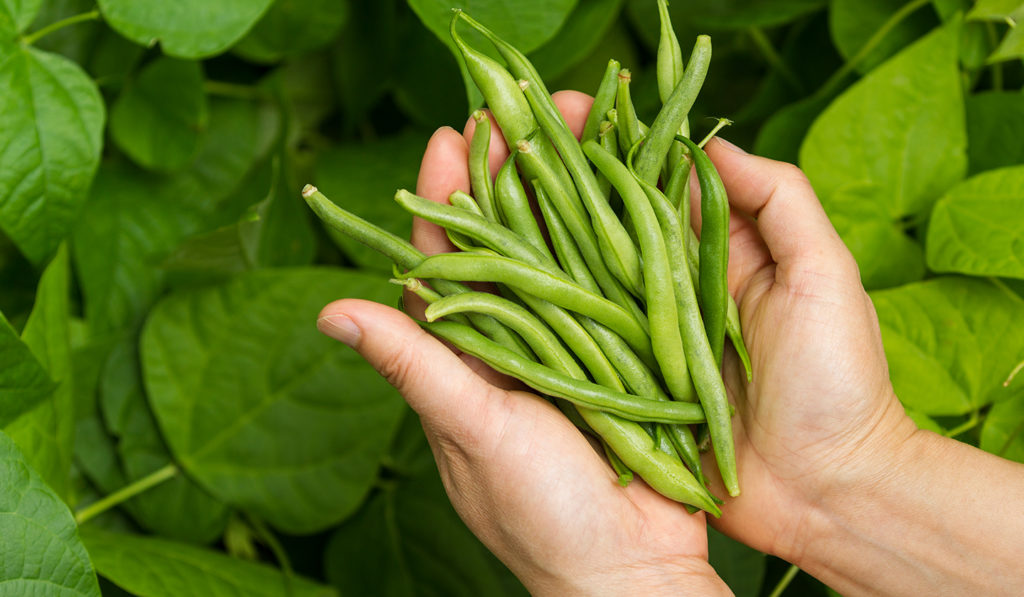

beyond the basics
-
soil & potting
Grow impatiens in nutrient-rich soil with good drainage. Adding peat moss to clay soil will help. If you’re planting in a container such as a window box or hanging basket, use a good-draining potting soil like Miracle-Gro® potting mix.
Enrich your soil with nutrients. Fertilize your soil with aged compost before planting. This organic matter will provide your impatiens the extra nutrients they need to thrive.
Plant food makes a big difference. Add a slow-release granular plant food at planting time, like Miracle-Gro® Shake ‘n Feed All Purpose Plant Food. Throughout the growing season, add a water-soluble plant food every two weeks such as Miracle-Gro® Water Soluble Bloom Booster. Use a water-soluble plant food every two weeks according to the instructions. You can also reapply the slow-release plant food midway through the season. Let’s boost those blooms!
Planting Impatiens close together encourages them to grow taller. Space them about six inches apart. Not any closer, because the crowding could encourage mold to grow. If you want your Impatiens to act like more of a sprawling ground cover, space them further apart, about a foot.
-
companion planting
Impatiens are good in a veggie garden because their cheery flowers attract pollinators. They also make excellent companions for other plants and flowers like Asparagus fern, Begonias, Bacopa, Coleus, Fuchsia, Sweet potato vine and White Baby’s Breath.
-
blooms
Impatiens provide a bounty of brightly colored blooms, even in shady areas. Colours include white, red, pink, violet, coral, purple, and yellow.
-
pest control
Impatiens are fairly pest resistant, but you may get Aphids (yellowish-green clusters of small insects) or Red Spider Mites (tiny red bugs and white dusty substance under leaves). Fight these pests with a gentle insecticide like Ortho® Bug B Gon ECO Insecticidial Soap. For prevention, try planting aromatic herbs nearby, like chamomile, garlic or rosemary.
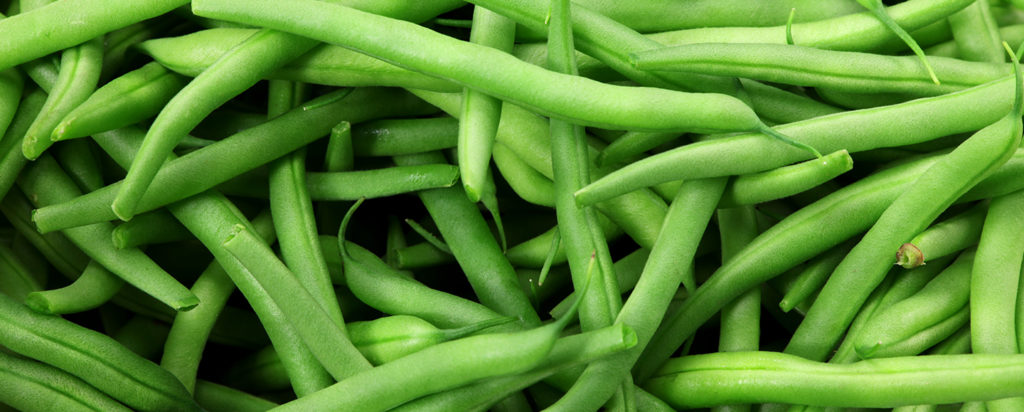
troubleshooting
-
what’s with the shrivelling blooms?
Impatiens blooms do have a life cycle and wilt naturally, but if all the blooms go suddenly at the same time, it’s probably a combination of too much heat and sun, and not enough water. Impatiens prefer shady, partial sun locations that shield them from peak daytime sun. Impatiens transplant well if you use lots of water, so move them to a shadier space.
-
why are my plants wilting?
Not enough water. Impatiens want consistently moist soil that doesn’t get soggy. Leaf drop and bud drop are other signs of drought stress.
-
what are these ringed spots?
Probably the Impatiens Necrotic Spot Virus. This incurable virus is spread by bugs known as Thrips. Unfortunately, there is no treatment. Stop the spread by uprooting and tossing the plant in a yard waste bag. Once it’s contained you can start over.
-
why is there powdery white stuff on the leaves?
It’s probably Downy Mildew, which can causes leaves to shrivel. It begins as a yellow or white stippling on the underside of the leaves. Prune infected leaves on generally healthy plants, and remove badly infected plants entirely. For maintenance, keep your beds clear of damp, rotting plant material.

impatiens
aka impatiens walleriana
Bright, colourful and fast growing, in even the shade. Impatiens have the power to pretty things up nearly everywhere. Garden beds, planter boxes and even hanging baskets.
variations
Standard impatiens: Impatiens walleriana New Guinea impatiens: Impatiens hawkeri
light
shade or partial sun
Unlike most flowers, Impatiens grow well in shady conditions. The exception are the New Guinea varieties that prefer partial sun. If you can, pick a spot that’s protected from the wind.
water + feeding
thirsty
They like moist soil so keep the water coming. Two inches a week is a general rule. That’s an hour of sprinkler time if there’s no rain. Be careful not to overwater. Long periods of wet soil encourages mold and rot. A layer of mulch helps the soil retain moisture and protect impatiens from wilting in summer heat. Impatiens in containers need more regular watering than ones planted in your garden.
toxic
non-toxic
safe for people and pets.
size
really small to small-ish
Dwarf varieties only grow 6 inches. While bigger types can grow to 2 feet high with the proper care.
pro tip
dead heads
“Dead head” your Impatiens for continuous blooms. When you see a blossom start to brown and wither, pinch it off and toss it in your yard waste. This will encourage the plant to make more beautiful new flowers.
fun fact
so sweet!
In many cultures, Impatiens are symbolic of motherly love. But there are some cultures where the flower represents impatience, because the plant eagerly disperses seeds.
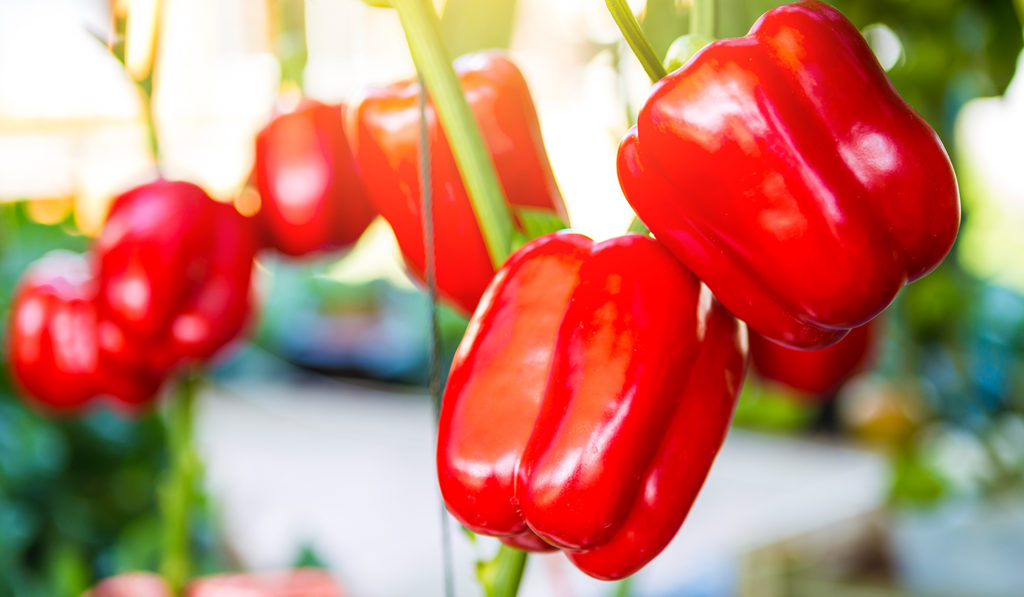

beyond the basics
-
soil & potting
Grow impatiens in nutrient-rich soil with good drainage. Adding peat moss to clay soil will help. If you’re planting in a container such as a window box or hanging basket, use a good-draining potting soil like Miracle-Gro® potting mix.
Enrich your soil with nutrients. Fertilize your soil with aged compost before planting. This organic matter will provide your impatiens the extra nutrients they need to thrive.
Plant food makes a big difference. Add a slow-release granular plant food at planting time, like Miracle-Gro® Shake ‘n Feed All Purpose Plant Food. Throughout the growing season, add a water-soluble plant food every two weeks such as Miracle-Gro® Water Soluble Bloom Booster. Use a water-soluble plant food every two weeks according to the instructions. You can also reapply the slow-release plant food midway through the season. Let’s boost those blooms!
Planting Impatiens close together encourages them to grow taller. Space them about six inches apart. Not any closer, because the crowding could encourage mold to grow. If you want your Impatiens to act like more of a sprawling ground cover, space them further apart, about a foot.
-
companion planting
Impatiens are good in a veggie garden because their cheery flowers attract pollinators. They also make excellent companions for other plants and flowers like Asparagus fern, Begonias, Bacopa, Coleus, Fuchsia, Sweet potato vine and White Baby’s Breath.
-
blooms
Impatiens provide a bounty of brightly colored blooms, even in shady areas. Colours include white, red, pink, violet, coral, purple, and yellow.
-
pest control
Impatiens are fairly pest resistant, but you may get Aphids (yellowish-green clusters of small insects) or Red Spider Mites (tiny red bugs and white dusty substance under leaves). Fight these pests with a gentle insecticide like Ortho® Bug B Gon ECO Insecticidial Soap. For prevention, try planting aromatic herbs nearby, like chamomile, garlic or rosemary.
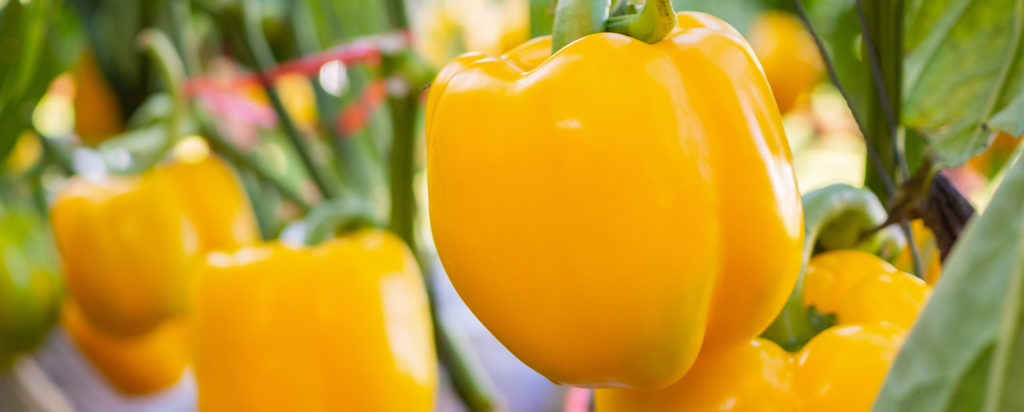
troubleshooting
-
what’s with the shrivelling blooms?
Impatiens blooms do have a life cycle and wilt naturally, but if all the blooms go suddenly at the same time, it’s probably a combination of too much heat and sun, and not enough water. Impatiens prefer shady, partial sun locations that shield them from peak daytime sun. Impatiens transplant well if you use lots of water, so move them to a shadier space.
-
why are my plants wilting?
Not enough water. Impatiens want consistently moist soil that doesn’t get soggy. Leaf drop and bud drop are other signs of drought stress.
-
what are these ringed spots?
Probably the Impatiens Necrotic Spot Virus. This incurable virus is spread by bugs known as Thrips. Unfortunately, there is no treatment. Stop the spread by uprooting and tossing the plant in a yard waste bag. Once it’s contained you can start over.
-
why is there powdery white stuff on the leaves?
It’s probably Downy Mildew, which can causes leaves to shrivel. It begins as a yellow or white stippling on the underside of the leaves. Prune infected leaves on generally healthy plants, and remove badly infected plants entirely. For maintenance, keep your beds clear of damp, rotting plant material.

impatiens
aka impatiens walleriana
Bright, colourful and fast growing, in even the shade. Impatiens have the power to pretty things up nearly everywhere. Garden beds, planter boxes and even hanging baskets.
variations
Standard impatiens: Impatiens walleriana New Guinea impatiens: Impatiens hawkeri
light
shade or partial sun
Unlike most flowers, Impatiens grow well in shady conditions. The exception are the New Guinea varieties that prefer partial sun. If you can, pick a spot that’s protected from the wind.
water + feeding
thirsty
They like moist soil so keep the water coming. Two inches a week is a general rule. That’s an hour of sprinkler time if there’s no rain. Be careful not to overwater. Long periods of wet soil encourages mold and rot. A layer of mulch helps the soil retain moisture and protect impatiens from wilting in summer heat. Impatiens in containers need more regular watering than ones planted in your garden.
toxic
non-toxic
safe for people and pets.
size
really small to small-ish
Dwarf varieties only grow 6 inches. While bigger types can grow to 2 feet high with the proper care.
pro tip
dead heads
“Dead head” your Impatiens for continuous blooms. When you see a blossom start to brown and wither, pinch it off and toss it in your yard waste. This will encourage the plant to make more beautiful new flowers.
fun fact
so sweet!
In many cultures, Impatiens are symbolic of motherly love. But there are some cultures where the flower represents impatience, because the plant eagerly disperses seeds.


beyond the basics
-
soil & potting
Grow impatiens in nutrient-rich soil with good drainage. Adding peat moss to clay soil will help. If you’re planting in a container such as a window box or hanging basket, use a good-draining potting soil like Miracle-Gro® potting mix.
Enrich your soil with nutrients. Fertilize your soil with aged compost before planting. This organic matter will provide your impatiens the extra nutrients they need to thrive.
Plant food makes a big difference. Add a slow-release granular plant food at planting time, like Miracle-Gro® Shake ‘n Feed All Purpose Plant Food. Throughout the growing season, add a water-soluble plant food every two weeks such as Miracle-Gro® Water Soluble Bloom Booster. Use a water-soluble plant food every two weeks according to the instructions. You can also reapply the slow-release plant food midway through the season. Let’s boost those blooms!
Planting Impatiens close together encourages them to grow taller. Space them about six inches apart. Not any closer, because the crowding could encourage mold to grow. If you want your Impatiens to act like more of a sprawling ground cover, space them further apart, about a foot.
-
companion planting
Impatiens are good in a veggie garden because their cheery flowers attract pollinators. They also make excellent companions for other plants and flowers like Asparagus fern, Begonias, Bacopa, Coleus, Fuchsia, Sweet potato vine and White Baby’s Breath.
-
blooms
Impatiens provide a bounty of brightly colored blooms, even in shady areas. Colours include white, red, pink, violet, coral, purple, and yellow.
-
pest control
Impatiens are fairly pest resistant, but you may get Aphids (yellowish-green clusters of small insects) or Red Spider Mites (tiny red bugs and white dusty substance under leaves). Fight these pests with a gentle insecticide like Ortho® Bug B Gon ECO Insecticidial Soap. For prevention, try planting aromatic herbs nearby, like chamomile, garlic or rosemary.
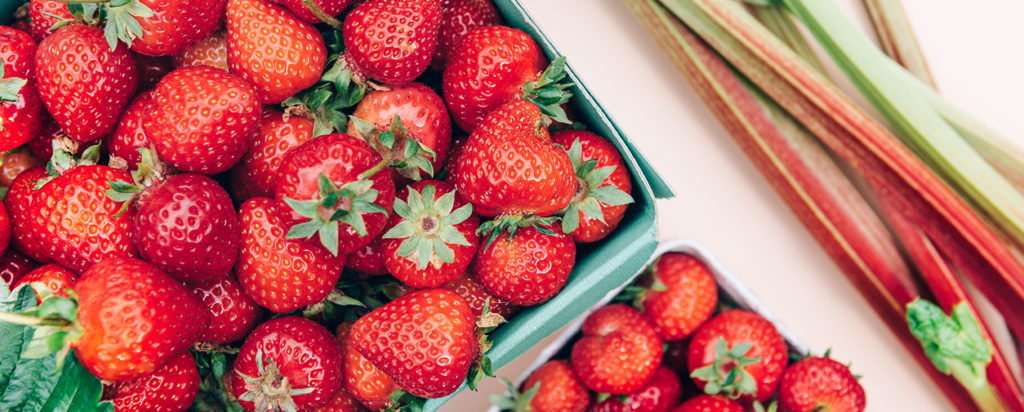
troubleshooting
-
what’s with the shrivelling blooms?
Impatiens blooms do have a life cycle and wilt naturally, but if all the blooms go suddenly at the same time, it’s probably a combination of too much heat and sun, and not enough water. Impatiens prefer shady, partial sun locations that shield them from peak daytime sun. Impatiens transplant well if you use lots of water, so move them to a shadier space.
-
why are my plants wilting?
Not enough water. Impatiens want consistently moist soil that doesn’t get soggy. Leaf drop and bud drop are other signs of drought stress.
-
what are these ringed spots?
Probably the Impatiens Necrotic Spot Virus. This incurable virus is spread by bugs known as Thrips. Unfortunately, there is no treatment. Stop the spread by uprooting and tossing the plant in a yard waste bag. Once it’s contained you can start over.
-
why is there powdery white stuff on the leaves?
It’s probably Downy Mildew, which can causes leaves to shrivel. It begins as a yellow or white stippling on the underside of the leaves. Prune infected leaves on generally healthy plants, and remove badly infected plants entirely. For maintenance, keep your beds clear of damp, rotting plant material.

